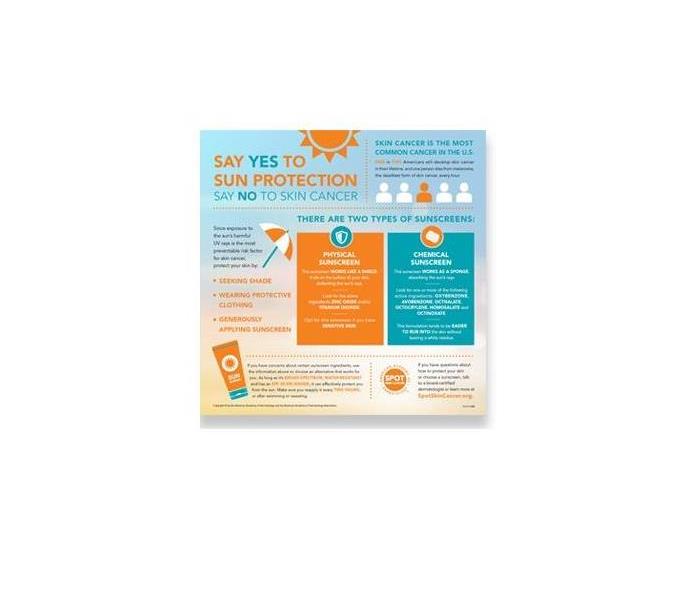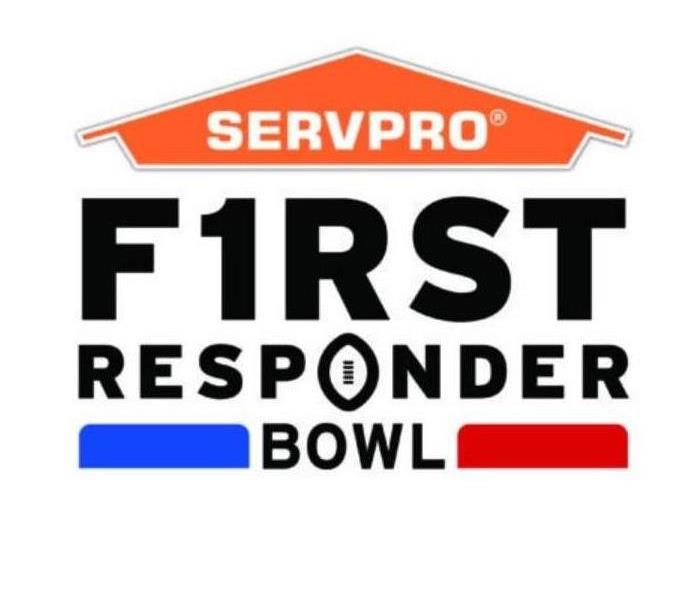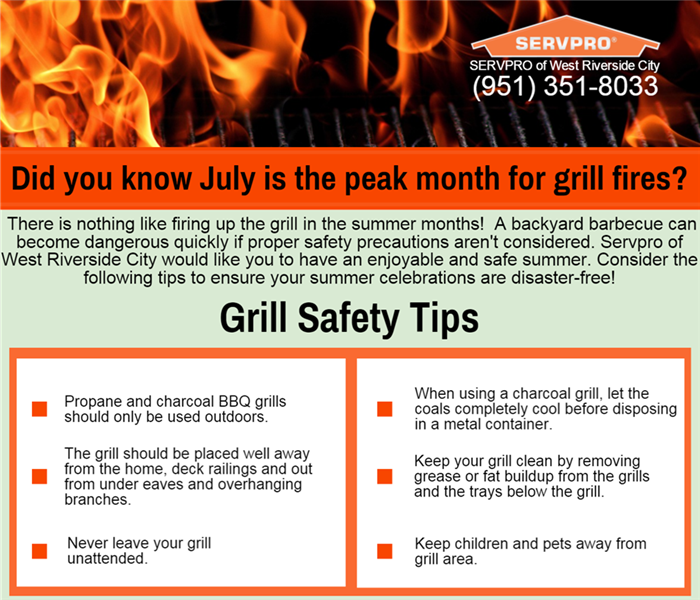Archived Community Blog Posts
How Can Residents Thank our Riverside First Responders?
10/27/2021 (Permalink)
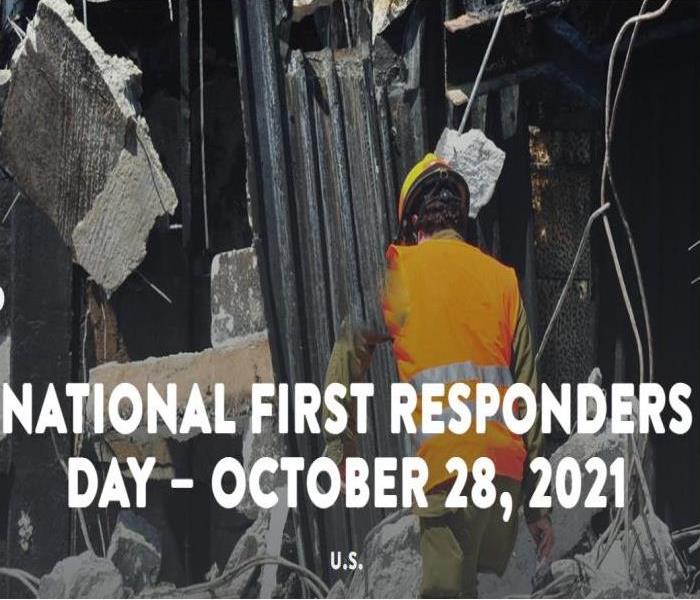 A simple "Thank you for your service" can be a great way to show you respect and appreciate what he or she is doing for the community!
A simple "Thank you for your service" can be a great way to show you respect and appreciate what he or she is doing for the community!
First responders' duties bring them into harm's way every day. Police officers, firefighters and paramedics put themselves on the front lines of dangerous and traumatic events, and it's common to wonder how you can thank these individuals, perhaps lessening the emotional burden of their work.
The following list is just a sampling of the many ways you can show a first responder that you care. These are good ideas to start with, and apply at any time of the year.
1. Cook a meal
Bringing home-cooked food to the local police or fire station can show the local first responder community that you care. Day-to-day life as a police officer, firefighter or paramedic can be stressful and the schedule irregular, meaning that home-cooked meals may be a luxury that will make these first responders grateful. And if you take the meal over yourself, you have a great chance to say a verbal thanks as well. Of course, since an alarm can sound at any time, it may be best if the meal is one that can be returned to later if the diners have to leave off in the middle.
2. Donate to a good cause
There are numerous charity drives in any given community to support the fire departments, police forces and more. A gift to one of these causes can make a material difference in the lives of first responders and the family members. Even if you don't possess the material means to make a big donation, there are plenty of ways to help charities, including organizing or volunteering at a drive or other event.
3. Send a letter of thanks
These days, many people don't take the time to write letters – electronic communication has driven paper out of favor. This means that sending a physical letter thanking first responders for their service may take on greater importance, feeling more personal, permanent and heartfelt than email. If you gather multiple letters from the community and deliver them all at once, the impression on the recipients could be significant.
The first responders in your community will be grateful for your thanks and support.
4. Send a practical gift basket
A gift basket is a classy way to express thanks. If you customize one of these presents to suit the tastes and needs of the local fire department or police force, it could be an incredibly thoughtful choice, one that will make your gratitude clear. Such a basket could include gift cards to restaurants in the area, allowing first responders to relax and unwind with good food between their high-stress assignments.
5. Use word of mouth
When you have a good experience with local first responders, spreading the word either online or in person can do a great service to the department. It's not a direct thanks to the police, fire and paramedic personnel, but speaking well of these individuals is a gesture of gratitude, one that is easy and impactful.
6. Just say 'thanks'
Just about every day, you likely pass police officers, firefighters and paramedics going about their daily business. Just saying a simple "Thank you for your service" can be a great way to show that individual you respect and appreciate what he or she is doing for the community. It's extremely simple, and could make a first responder's day.
Do your Children Know What To Do in the Event of a Disaster?
9/20/2021 (Permalink)
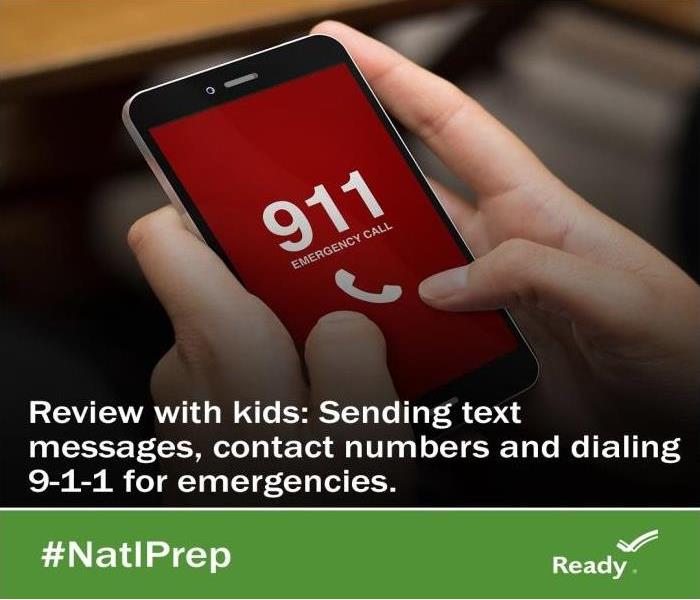 BEFORE an emergency, teach your child how to dial 911 #YouthPrep
BEFORE an emergency, teach your child how to dial 911 #YouthPrep
National Preparedness Month September 19-25: Teach Youth About Preparedness
Week Four of National Preparedness Month focuses on Youth.
Many families are not together during an emergency, its important that your children and young adults know what to do during different types of emergencies.
Talk to your kids about preparing for emergencies and what to do in case you are separated. Reassure them by providing information about how they can get involved.
How Can You Prepare Your Family?
Being prepared for disasters starts at home. Everyone can be part of helping to prepare for emergencies. Young children and teens alike can be a part of the process. As a parent, guardian, or other family member, you have an important role to play when it comes to protecting the children in your life and helping them be prepared in case disaster strikes.
We will touch on how to build your family emergency plan, how you can help children cope if they’ve experienced a disaster, and tips to help your children be ready when disaster strikes. With these tools, both kids and their families can be prepared whether they’re at home, school, or anywhere else.
How to Build and Emergency Plan
Some disasters strike without any warning, and family members may not all be in the same place. How will you get in touch with each other? Where will you meet? How will you get out of your house in case of a fire? What if your neighborhood is being evacuated? It's important to make a plan, now, so that you will know what to do, how to find each other, and how to communicate in an emergency.
How to Build a Kit
Being prepared for an emergency isn't just about staying safe during a storm or a disaster. It's also about how to stay comfortable, clean, fed, and healthy afterwards—when a storm or disaster may have knocked out electricity.
If you lost power, how would you eat? The refrigerator wouldn’t keep your food cold. The microwave couldn’t warm things up. You might not get clean water out of your faucets. How would you find out if it was safe to play outside? Not from your TV or computer!
If power is out, you also might not be able to go to the store or the bank. Being prepared means having your own food, water, cash, and other supplies to last for at least three days, and possibly longer if you are in a remote or hard-to-reach area.
Check out our blog on How Build a Basic Disaster Emergency Supply Kit
Helping Children Cope
Disasters can leave children and teens feeling frightened, confused and insecure. Their responses can be quite varied. It's important to not only recognize these reactions, but also help children cope with their emotions.
Encourage dialogue and answer questions
Listen to your kids. Ask them about their feelings and validate their concerns. When they ask questions, give just the amount of information you feel your child needs.
Make time for them and find support
Help kids understand that they are safe and secure by talking, playing, and doing other family activities with them. Build support networks with friends, family, and community organizations to help you cope, which can also help your children cope.
Keep to a routine
Help your children feel as if they still have a sense of structure, which can make them feel more relaxed. When schools and childcare open again, help children return to normal activities like going to class, sports, and play groups.
Risk Factors
For many kids, reactions to disasters are short-term. But some children can be at risk for more long-term psychological distress. Three risk factors for this longer-lasting response are:
- Direct exposure to the disaster such as being evacuated, observing injuries of others, or experiencing injury.
- Loss/grief relating to the death or serious injury of family or friends.
- Ongoing stress from secondary effects, such as temporary housing, loss of social networks, loss of personal property, or parent's unemployment.
Stay involved with your children and young adults. Our blogs for the month of September all focus on emergency preparedness.
SERVPRO of West Riverside City blogs
Emergency Preparedness, Ways to be Involved in Your Riverside Community
9/15/2021 (Permalink)
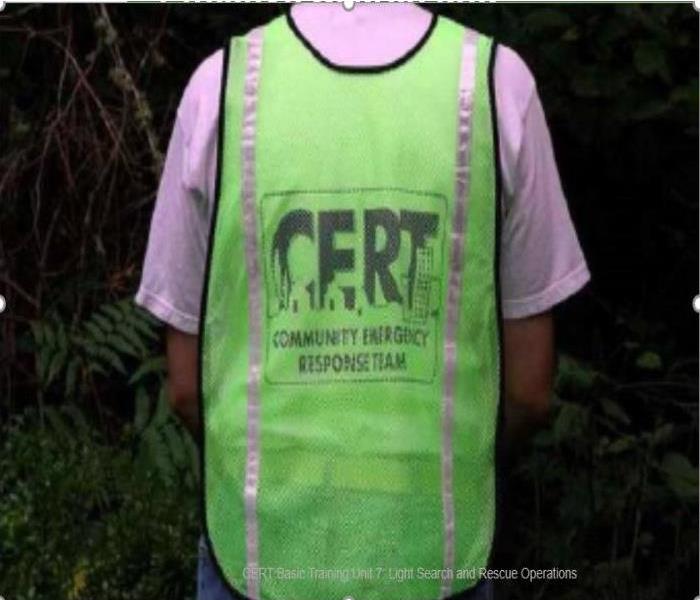 CERT members can assist others following an event when professional responders are not immediately available to help
CERT members can assist others following an event when professional responders are not immediately available to help
Week 3 September 12-18: Low-Cost, No-Cost Preparedness
There are many great organizations and groups you can join that will allow you to help in your community during disasters, some of these are at no cost. Knowing you are able to help others is empowering and highly rewarding.
CPR
You can make a save a life by learning hands-only CPR.
Why Learn Hands-Only CPR:
80% occur at home – so the life you are most likely to help save is a family member or friend. Sudden Cardiac Arrest is an electrical problem with the heart where it stops beating and pumping blood. That causes the brain to shut down, so the person suddenly collapses and is unconscious. EMS can restart the heart using a defibrillator (AED) and/or medications – but take 5 or more minutes to arrive. Hands-Only CPR can keep the heart and brain alive until EMS takes over. Mouth-to-mouth breathing is not necessary – there is oxygen in the blood. CERT-Community Emergency Response Team
CERT Program educates people about disaster preparedness for hazards that may impact their area and trains them in basic disaster response skills, such as fire safety, light search and rescue, team organization, and disaster medical operations.
Using the training learned in the classroom and during exercises, CERT members can assist others in their neighborhood or workplace following an event when professional responders are not immediately available to help.
CERT members also are encouraged to support emergency response agencies by taking a more active role in emergency preparedness projects in their community.
Visit RivCoCERT.org
You Are the Help Until Help Arrives
designed by FEMA, are trainings that can be taken online or in-person, where you learn through simple steps how to save a life before a professional arrives.
Learn five simple steps that may save a life
Call 9-1-1Stay SafeStop the BleedingPosition the InjuredProvide ComfortLife-threatening emergencies can happen fast and emergency responders aren’t always nearby.
You may be able to save a life by taking simple actions immediately.
You Are the Help Until Help Arrives.
Click on the links below to learn more about how you can help:
An animated interactive videoA web-based training programA downloadable instructor guide and student tools to provide in-person trainingSet up Riverside Alert
Riverside Alert allows the City of Riverside to provide you with critical information quickly in a variety of situations, such as unexpected road closures, utility outages, missing persons and evacuations of buildings or neighborhoods.
You will receive time-sensitive messages wherever you specify, such as your home, mobile or business phones, email address, text messages and more. You pick where, you pick how.
The City of Riverside has launched a mass notification service that allows us to alert you in the case of an emergency. You opt-in to enter your contact information and subscribe to notifications you care about. The information you provide is protected and will not be used for any other purpose.
How it works
When we issue a notification about a potential safety hazard or concern, you will receive a message on the voice or text communication methods that you have selected. If requested for the notification, you can confirm that you have received the message and you will not be contacted by any subsequent methods regarding that particular notification. If you do not confirm, the system will continue to attempt to reach you at all of the contact paths that you have registered.
Sign up for notifications
Create an account and add your contact and location information into Riverside Alert. All information you provide will be kept strictly confidential.
Sign Up Here
How to Build a Basic Disaster Emergency Supply Kit
9/9/2021 (Permalink)
 After an emergency, you may need to survive on your own. Being prepared means having your own food, water and other supplies to last for several days
After an emergency, you may need to survive on your own. Being prepared means having your own food, water and other supplies to last for several days
Being prepared means being equipped with the proper supplies you may need in the event of an emergency or disaster.
We've experienced the challenges of gathering supplies during COVID-19 sheltering in place. Many stores were out of basic necessities such as hand sanitizer, toilet paper, water and N95 masks along with a list of other items. How can you be prepared in advance? Week two of National Preparedness Month helps us with building a kit. We will provide tips with the help of Ready.gov on putting together your kit based on your family's needs.
After an emergency, you may need to survive on your own for several days. Being prepared means having your own food, water and other supplies to last for several days. A disaster supplies kit is a collection of basic items your household may need in the event of an emergency.
Week 2 September 5-11: Build A Kit
Gather supplies that will last for several days after a disaster for everyone living in your home. Don’t forget to consider the unique needs each person or pet may have in case you have to evacuate quickly. Update your kits and supplies based on recommendations by the Centers for Disease Control.
Make sure your emergency kit is stocked with the items on the checklist below. Download a printable version to take with you to the store. Once you take a look at the basic items consider what unique needs your family might have, such as supplies for seniors or pets (Check out our next Blog for pets.
Basic Disaster Supplies Kit
To assemble your kit store items in airtight plastic bags and put your entire disaster supplies kit in one or two easy-to-carry containers such as plastic bins or a duffel bag.
A basic emergency supply kit could include the following recommended items:
- Water (one gallon per person per day for several days, for drinking and sanitation)
- Food (at least a three-day supply of non-perishable food)
- Battery-powered or hand crank radio and a NOAA Weather Radio with tone alert
- Flashlight
- First aid kit
- Extra batteries
- Whistle (to signal for help)
- Dust mask (to help filter contaminated air)
- Plastic sheeting and duct tape (to shelter in place)
- Moist towelettes, garbage bags and plastic ties (for personal sanitation)
- Wrench or pliers (to turn off utilities)
- Manual can opener (for food)
- Local maps
- Cell phone with chargers and a backup battery
Consider adding the following items to your emergency supply kit based on your individual needs:
- Non-prescription medications such as pain relievers, anti-diarrhea medication, antacids or laxatives
- Prescription eyeglasses and contact lens solution
- Infant formula, bottles, diapers, wipes and diaper rash cream
- Pet food and extra water for your pet
- Cash or traveler's checks
- Important family documents such as copies of insurance policies, identification and bank account records saved electronically or in a waterproof, portable container
- Sleeping bag or warm blanket for each person
- Complete change of clothing appropriate for your climate and sturdy shoes
- Fire extinguisher
- Matches in a waterproof container
- Feminine supplies and personal hygiene items
- Mess kits, paper cups, plates, paper towels and plastic utensils
- Paper and pencil
- Books, games, puzzles or other activities for children
Maintaining Your Kit
After assembling your kit remember to maintain it so it’s ready when needed:
- Keep canned food in a cool, dry place.
- Store boxed food in tightly closed plastic or metal containers.
- Replace expired items as needed.
- Re-think your needs every year and update your kit as your family’s needs change.
Kit Storage Locations
Since you do not know where you will be when an emergency occurs, prepare supplies for home, work and cars.
- Home: Keep this kit in a designated place and have it ready in case you have to leave your home quickly. Make sure all family members know where the kit is kept.
- Work: Be prepared to shelter at work for at least 24 hours. Your work kit should include food, water and other necessities like medicines, as well as comfortable walking shoes, stored in a “grab and go” case.
- Car: In case you are stranded, keep a kit of emergency supplies in your car.
How Can You Prepare Your Pets For a Disaster
9/8/2021 (Permalink)
 SERVPRO of West Riverside City's mascot Ellie is ready for any disaster!
SERVPRO of West Riverside City's mascot Ellie is ready for any disaster!
Your pets are an important member of your family, so they need to be included in your family’s emergency plan.
To prepare for the unexpected follow these tips with your pets in mind:
- Make a plan.
- Build an emergency kit.
- Stay informed.
Make a Plan
If you have a plan in place for you and your pets, you will likely encounter less difficulty, stress and worry when you need to make a decision during an emergency. If local officials ask you to evacuate, that means your pet should evacuate too. If you leave your pets behind, they may end up lost, injured or worse.
What can you do right now?
- Make sure that cats and dogs are wearing collars and identification tags
- Put your cell phone number on your pet's tag.
Things to include in your plan:
- Have an evacuation plan for your pet. Many public shelters and hotels do not allow pets inside. Know a safe place where you can take your pets before disasters and emergencies happen.
- Develop a buddy system. Plan with neighbors, friends or relatives to make sure that someone is available to care for or evacuate your pets if you are unable to do so.
- Have your pet microchipped. Make sure to keep your address and phone number up-to-date and include contact information for an emergency contact outside of your immediate area.
- Contact your local emergency management office, animal shelter or animal control office to get additional advice and information if you’re unsure how to care for your pet in case of an emergency.
Here is a list of animal-friendly places handy, and call ahead for a reservation as soon as you think you might have to leave your home.
Build a Kit for Your Pet
Just as you do with your family’s emergency supply kit, think first about the basics for survival, such as food and water. Have two kits, one larger kit if you are sheltering in place and one lightweight version for if you need to evacuate. Review your kits regularly to ensure that their contents, especially foods and medicines, are fresh.
Here are some items you may want to include in an emergency kit for your pet:
- Food. Keep several days’ supply of food in an airtight, waterproof container.
- Water. Store a water bowl and several days’ supply of water.
- Medicine. Keep an extra supply of the medicine your pet takes on a regular basis in a waterproof container.
- First aid kit. Talk to your veterinarian about what is most appropriate for your pet’s emergency medical needs.
- Collar with ID tag and a harness or leash. Include a backup leash, collar and ID tag. Have copies of your pet’s registration information and other relevant documents in a waterproof container and available electronically.
- Traveling bag, crate or sturdy carrier, ideally one for each pet.
- Grooming items. Pet shampoo, conditioner and other items, in case your pet needs some cleaning up.
- Sanitation needs. Include pet litter and litter box (if appropriate), newspapers, paper towels, plastic trash bags and household chlorine bleach to provide for your pet’s sanitation needs.
- A picture of you and your pet together. If you become separated from your pet during an emergency, a picture of you and your pet together will help you document ownership and allow others to assist you in identifying your pet.
- Familiar items. Put favorite toys, treats or bedding in your kit. Familiar items can help reduce stress for your pet.
Tips for Large Animals
If you have pets such as horses, goats or pigs on your property, be sure to prepare before a disaster.
In addition to the tips above:
- Ensure all animals have some form of identification.
- Evacuate animals earlier, whenever possible. Map out primary and secondary routes in advance.
- Make available vehicles and trailers needed for transporting and supporting each type of animal. Also make available experienced handlers and drivers.
- Ensure destinations have food, water, veterinary care and handling equipment.
- If evacuation is not possible, animal owners must decide whether to move large animals to a barn or turn them loose outside.
Stay Informed
Being prepared and staying informed of current conditions. Here are some ways you can stay informed:
- Pay attention to wireless emergency alerts for local alerts and warnings sent by state and local public safety officials.
- Listen to local officials when told to evacuate or shelter in place.
- Download the FEMA app and get weather alerts from the National Weather Service, for up to five different locations anywhere in the United States.
- Always bring pets indoors at the first sign or warning of a storm or disaster.
Can you Help Spread the Word to Clear Riverside Shelter?
8/23/2021 (Permalink)
 I'm a male, 51.10 lbs, white & gray Siberian Husky.
Estimated to be about 2 yrs, 2 mo old.
I have been at the shelter since 06/08/2! Can I be yours?
I'm a male, 51.10 lbs, white & gray Siberian Husky.
Estimated to be about 2 yrs, 2 mo old.
I have been at the shelter since 06/08/2! Can I be yours?
NBC Universal Local is teaming up with hundreds of shelters across the country to host Clear the Shelters
A nationwide pet adoption drive in August 2021 that helps find loving homes for animals in need. More than 551,000 pets have found their forever homes since 2015.
SERVPRO would like to share some of the available pups located at Riverside County Department of Animal Services
There are currently 126 dogs available for adoption. They come in all sizes, breeds and ages. Some have good training skills, others need a little more attention in training, any dog can be trained out of bad habits.
Our Rescue Cattle Dog
Take our Cattle dog Ellie, she had so much going against her when we found her at the shelter. She was just an 8 week old pup found roaming the streets. Due to her biting and hurting the other pups, she was placed in her own kennel and marked aggressive.
Being a herding dog, she was high energy and needed mental and physical stimulation. On top of that she barked…she barked a lot!
Nothing a dog trainer couldn't help with! This dog grew up to be sociable, obedient, loving pup. We were able to leave her at day camps and she got along great with other doggos. Addressing her barking was the most challenging. We attempted several methods to address the barking as suggested from her trainer, until we found the right remedy. As far as her high energy, walks and play time twice a day helped along with additional hikes & beach days addressed her energy level. She is the sweetest!
Visit our social media pages to take a look at some of the pups available at:
We will post different groups of dogs, by age, breed, and time at the shelter! Stop by the shelter and see them for yourself. It will be hard to make a choice, but we are confident you will find one that will perfectly fit your family.
Summer Fun Concerts in the Park Return to Riverside Starting July 7th!
7/5/2021 (Permalink)
 This FREE family-oriented event provides a fun and exciting experience for all ages to enjoy and includes live music!
This FREE family-oriented event provides a fun and exciting experience for all ages to enjoy and includes live music!
Looking forward to getting outdoors, being with your community and having a good time?
The City of Riverside Parks, Recreation, and Community Services Department (PRCSD) is bringing back the Summer Concerts Series just in time to cool down the summer heat!
This FREE family-oriented event provides a fun and exciting experience for all ages to enjoy and includes live music with some of the best local artists from Southern California. Participants are treated to an eclectic variety of excellent music with a different genre on display each Wednesday for the month of July.
In addition, the Summer Fun Concerts in the Park also offers a variety of food vendors and refreshments along with a beer garden. Participants may also purchase an event shirt or hat for $20. A t-shirt and hat combo will also be available for $35 and can be purchased at the event. All proceeds serve to generate scholarships for underserved communities. To add to the fun, the City of Riverside PRCSD Wellness Vehicle will be present, providing fun activities and a variety of PRCSD swag for participants.
Here is the summer concert schedule:
Fairmont Park
2601 Fairmont Blvd.
July 7- Steel Rod - Top 40/variety
July 14- Nueva Era- Latin variety/Rockabilly
July 21- Stone Soul- Motown
July 28- Suave the Band- Latin (Cumba, Merengue, Salsa, Chacha)
Are Your Pets Prepared for Riverside Disasters? June is National Pet Preparedness Month!
6/16/2021 (Permalink)
 Riverside can experience disasters from earthquakes, wildfires, flooding & winds. If you had to evacuate are you prepared with a plan for your pet?
Riverside can experience disasters from earthquakes, wildfires, flooding & winds. If you had to evacuate are you prepared with a plan for your pet?
June is National Pet Preparedness Month
In Riverside, CA we can experience disasters from earthquakes, wildfires, flooding, and excessive winds. If you had to evacuate are you prepared with a plan for your pet?
Ready.gov has provided these tips to help pet owners during a disaster.
Your pets are an important member of your family, so they need to be included in your family’s emergency plan. To prepare for the unexpected follow these tips with your pets in mind:
- Make a plan.
- Build an emergency kit.
- Stay informed.
Make a Plan
If you have a plan in place for you and your pets, you will likely encounter less difficulty, stress and worry when you need to make a decision during an emergency. If local officials ask you to evacuate, that means your pet should evacuate too. If you leave your pets behind, they may end up lost, injured or worse.
Things to include in your plan:
- Have an evacuation plan for your pet. Many public shelters and hotels do not allow pets inside. Know a safe place where you can take your pets before disasters and emergencies happen.
- Develop a buddy system. Plan with neighbors, friends or relatives to make sure that someone is available to care for or evacuate your pets if you are unable to do so.
- Have your pet microchipped. Make sure to keep your address and phone number up-to-date and include contact information for an emergency contact outside of your immediate area.
- Contact your local emergency management office, animal shelter or animal control office to get additional advice and information if you’re unsure how to care for your pet in case of an emergency.
Build a Kit for Your Pet
Just as you do with your family’s emergency supply kit, think first about the basics for survival, such as food and water. Have two kits, one larger kit if you are sheltering in place and one lightweight version for if you need to evacuate. Review your kits regularly to ensure that their contents, especially foods and medicines, are fresh.
Here are some items you may want to include in an emergency kit for your pet:
- Food. Keep several days’ supply of food in an airtight, waterproof container.
- Water. Store a water bowl and several days’ supply of water.
- Medicine. Keep an extra supply of the medicine your pet takes on a regular basis in a waterproof container.
- First aid kit. Talk to your veterinarian about what is most appropriate for your pet’s emergency medical needs.
- Collar with ID tag and a harness or leash. Include a backup leash, collar and ID tag. Have copies of your pet’s registration information and other relevant documents in a waterproof container and available electronically.
- Traveling bag, crate or sturdy carrier, ideally one for each pet.
- Grooming items. Pet shampoo, conditioner and other items, in case your pet needs some cleaning up.
- Sanitation needs. Include pet litter and litter box (if appropriate), newspapers, paper towels, plastic trash bags and household chlorine bleach to provide for your pet’s sanitation needs.
- A picture of you and your pet together. If you become separated from your pet during an emergency, a picture of you and your pet together will help you document ownership and allow others to assist you in identifying your pet.
- Familiar items. Put favorite toys, treats or bedding in your kit. Familiar items can help reduce stress for your pet.
In addition to the tips above:
- Ensure all animals have some form of identification.
- Evacuate animals earlier, whenever possible. Map out primary and secondary routes in advance.
- Make available vehicles and trailers needed for transporting and supporting each type of animal. Also make available experienced handlers and drivers.
- Ensure destinations have food, water, veterinary care and handling equipment.
- If evacuation is not possible, animal owners must decide whether to move large animals to a barn or turn them loose outside.
Stay Informed
Being prepared and staying informed of current conditions. Here are some ways you can stay informed:
- Pay attention to wireless emergency alerts for local alerts and warnings sent by state and local public safety officials.
- Listen to local officials when told to evacuate or shelter in place.
- Download the FEMA app and get weather alerts from the National Weather Service, for up to five different locations anywhere in the United States.
- Always bring pets indoors at the first sign or warning of a storm or disaster.
Many public shelters and hotels do not allow pets inside, so plan ahead.
- Know a safe place where you can take your pets before disasters and emergencies happen.
- Plan with neighbors, friends or relatives to make sure that someone is available to care for or evacuate your pets if you are unable to do so.
- Contact your local emergency management office, animal shelter, or animal control office if you’re unsure how to take care of your pet during an emergency.
- Have your pets microchipped in case they get lost.
- Check out BringFido for pet friendly hotels in Riverside
Excessive Heat Wave Warning in Riverside County- Tips from Ready.gov
6/14/2021 (Permalink)
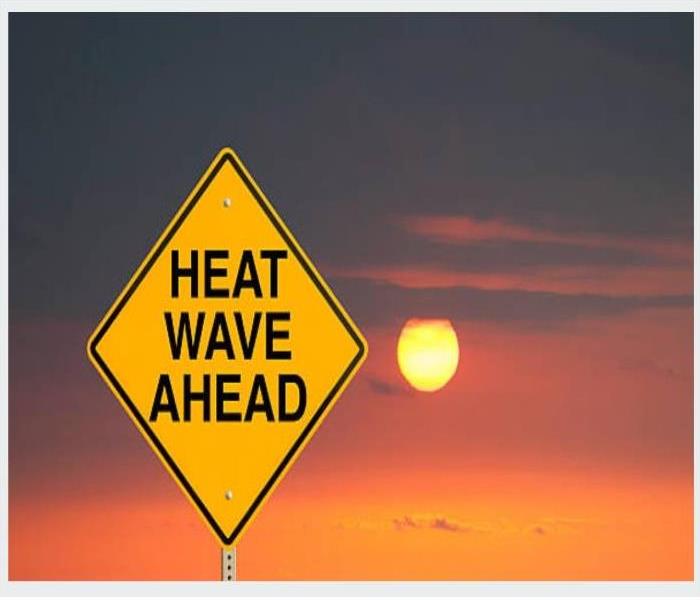 Riverside Residents should take precautions during a heat wave!
Riverside Residents should take precautions during a heat wave!
An excessive heat warning will be in effect in the Riverside metropolitan area and the Riverside County mountains starting at 10 a.m. Tuesday and lasting through 9 p.m. Saturday.
Temperatures in the Riverside area are expected to peak at 110 on Tuesday, then reach 109 on Wednesday, advised forecasters.
Ready.gov has outlined some tip to help keep safe from dehydration, heatstroke and keeping our families and pets safe.
Extreme heat is a period of high heat and humidity with temperatures above 90 degrees for at least two to three days. In extreme heat your body works extra hard to maintain a normal temperature, which can lead to death. In fact, extreme heat is responsible for the highest number of annual deaths among all weather-related hazards.
Remember:
- Extreme heat can occur quickly and without warning.
- Older adults, children and sick or overweight individuals are at greater risk from extreme heat.
- Humidity increases the feeling of heat as measured by a heat index.
IF YOU ARE UNDER AN EXTREME HEAT WARNING:
- Find air conditioning.
- Avoid strenuous activities.
- Wear light clothing.
- Check on family members and neighbors.
- Drink plenty of fluids.
- Watch for heat cramps, heat exhaustion and heat stroke.
- Never leave people or pets in a closed car.
HOW TO STAY SAFE WHEN EXTREME HEAT THREATENS
Prepare NOW
Find places in your community where you can go to get cool.
Try to keep your home cool:
- Do not rely on a fan as your primary cooling device.
- Cover windows with drapes or shades.
- Weather-strip doors and windows.
- Use window reflectors such as aluminum foil-covered cardboard to reflect heat back outside.
- Add insulation to keep the heat out.
- Use a powered attic ventilator, or attic fan, to regulate the heat level of a building’s attic by clearing hot air.
- Install window air conditioners and insulate around them.
- Learn to recognize the signs of heat illness. For more information visit: www.cdc.gov/disasters/extremeheat/warning.html
Be Safe DURING
Never leave a child, adult, or animal alone inside a vehicle on a warm day. Find places with air conditioning. Libraries, shopping malls, and community centers can be a cool place to beat the heat. Stay informed and check with local authorities about possible closures prior to going to cooling centers.
- If air conditioning is not available in your home:
- Contact Low Income Home Energy Assistance Program (LIHEAP) for help.
- Contact your local health department or locate an air-conditioned shelter in your area.
- Spend some time at a shopping mall or public library- even a few hours spent in air conditioning can help.
- Your community may set up emergency alternatives for cooling centers, such as using parked air-conditioned buses or movie theaters, as normal cooling centers may not have enough space for physical distancing. Pay attention to guidance from local officials to determine where the nearest cooling center is.
- Take cool showers or baths.
- Don’t rely solely on fans to keep you cool. While electric fans might provide some comfort, when temperatures are really hot, they won’t prevent heat-related illness.
- Use your stove and oven less to maintain a cooler temperature in your home.
- If you’re outside, find shade. Wear a hat wide enough to protect your face.
- Wear loose, lightweight, light-colored clothing.
- Drink plenty of fluids to stay hydrated. If you or someone you care for is on a special diet, ask a doctor what would be best.
- Do not use electric fans when the temperature outside is more than 95 degrees. You could increase the risk of heat-related illness. Fans create air flow and a false sense of comfort, but do not reduce body temperature.
- Avoid high-energy activities outdoors. Avoid working outdoors during the midday heat, if possible.
- Check yourself, family members, and neighbors for signs of heat-related illness
- Engage virtually with your community through video and phone calls. Know that it’s normal to feel anxious or stressed. Take care of your body and talk to someone if you are feeling upset.
Recognize and Respond
Know the signs of heat-related illnesses and ways to respond. At-risk populations for heat-related illness include older individuals and those with underlying health conditions. Know how to protect individuals especially at risk from extreme heat events.
If you are sick and need medical attention, contact your healthcare provider for advice and shelter in place, if you can. If you are experiencing a medical emergency, call 9-1-1.
HEAT CRAMPS
- Signs: Muscle pains or spasms in the stomach, arms or legs
- Actions: Go to a cooler location. Remove excess clothing. Take sips of cool sports drinks with salt and sugar. If you are sick and need medical attention, call your healthcare provider first. Follow your healthcare provider’s instructions about whether you should go to the hospital or cooler location yourself, as you may be putting others or yourself in greater risk for contracting COVID-19. If cramps last more than an hour, seek medical attention.
HEAT EXHAUSTION
- Signs: Heavy sweating, paleness, muscle cramps, tiredness, weakness, dizziness, headache, fainting, nausea, vomiting
- Actions: Go to an air-conditioned place and lie down. Loosen or remove clothing. Take a cool bath. Take sips of cool sports drinks with salt and sugar. Call your healthcare provider if symptoms get worse or last more than an hour.
HEAT STROKE
- Signs:
- Extremely high body temperature (above 103 degrees) taken orally
- Red, hot and dry skin with no sweat
- Rapid, strong pulse
- Dizziness, confusion or unconsciousness
- Actions: Call 9-1-1 or get the person to a hospital immediately. Cool down with whatever methods are available until medical help arrives.
Riverside County has identified cooling centers during this heatwave, click the link to find one near you.
https://www.capriverside.org/cool-centers
In the 92503 area code here are three centers you can go to during the heat of day:
- La Sierra Senior Center
- Arlanza Community Center Bryant Park
- Janet Goeske Center
City of Riverside Disaster Preparedness
5/31/2021 (Permalink)
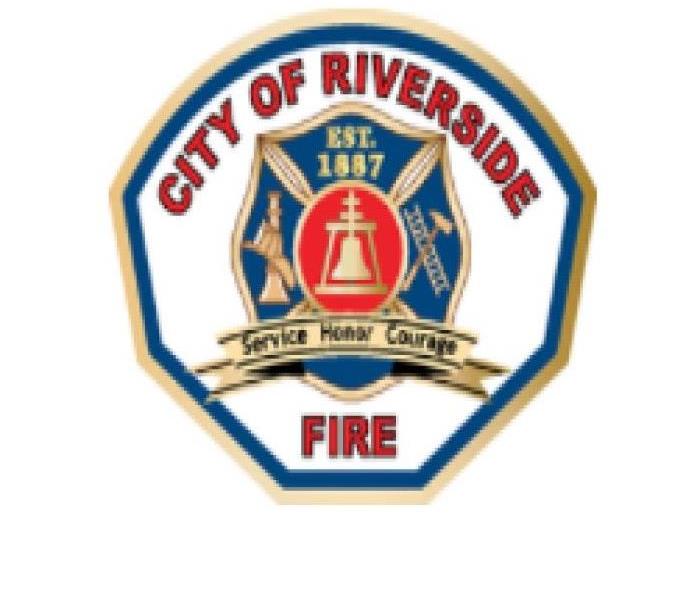 The City of Riverside is actively coordinating the City's response to disasters & assisting residents to prepare major events.
The City of Riverside is actively coordinating the City's response to disasters & assisting residents to prepare major events.
If you are a Riverside resident, we captured some important questions and links to understand how the City of Riverside is managing emergency disaster preparedness. See below for important pieces of information. Be prepared! Click links below for more information.
Emergency Management Disaster Preparedness
The City of Riverside's Emergency Management Office is actively coordinating the City's response to disasters as well as assisting residents to prepare for major events such as earthquakes, floods, hazardous material spills, plane crashes, train derailments, Africanized honey bees, and civil unrest.
Frequently Asked Questions
What is an "EOC?"
The Emergency Operation Center (EOC) is a secure facility where City department heads are able to work in the event of a large disaster. The facility provides centralization of City response to major events. The EOC allows for City departments to work closely together to make recovery more efficient for the community.
Does the City have a disaster plan?
Yes. The City is required by state and federal regulation to have a response and recovery plan. This plan covers everything from earthquakes and plane crashes to fires and flooding. This plan is maintained by the Emergency Manager and is continuously updated. A major update of the plan is done every five years. The newly revised plan is available to view at Riverside Public Library, Reference Section.
What is disaster preparedness?
Disaster preparedness is the means of preparing for a disaster before it happens. Some ways of preparing would be storage of food, water, and medicine in the event you had to be on your own for three days, planning escape routes, and setting up out of area contacts. These are just a few of the things you can do.
What types of disasters occur in the Riverside area?
Riverside is most vulnerable to floods. However, we can have earthquakes, draughts, fires, winds, Africanized honey bees, fire ants and situations such as civil unrest, terrorism and energy shortages.
Where are the nearest bomb and fallout shelters?
Bomb and fallout shelters were the direct result of a fear of nuclear war in the 1950's and 60's. With the decline of the Cold War the need for these shelters has disappeared. The City has developed extensive emergency plans and resources to ensure a coordinated response to any disaster, including a terrorist event. The best thing to do is listen to the radio or television for any information such as the location of any shelter - if established, or the need to 'shelter-in-place.
What do you mean by 'shelter-in-place'?
Shelter-in-place is intended to keep you safe while remaining indoors. For other natural disaster you may be directed by local officials to go to a community shelter for safety purposes. However, the intent of a 'shelter-in-place? means selecting a small, interior room, with no or few windows and taking refuge there.
An above ground location is preferable because some chemicals are heavier than air, and may seep into basements even if the windows are closed. Large storage closets, utility rooms, pantries, copy and conference rooms without exterior windows work well. Use duct tape and plastic sheeting (heavier than food wrap) to seal all cracks around the door and any vents into the room. There is no need to seal off your entire home or office with duct tape and plastic sheeting.
It is important to remember that instructions to 'shelter-in-place? mean shelter for a few hours, not days or weeks. There is little danger that the room in which you are taking shelter will run out of oxygen and you will suffocate. Keep listening to your radio or television until you are told all is safe.
Should I buy a gas mask?
Biological and radiological agents, which are airborne, are vapors, not gasses so there's no need for a gas mask. Vapors immediately begin to dissipate once they are released. When you leave an area, the risk of being affected by a vapor diminishes. Gas masks were developed for soldiers who have to remain in a specific area - that's the big difference. You can leave an area and always leave the risk. Chemical gasses need to be delivered in large quantities in order to kill or cause injuries. If you smell a vapor or gas, remember to stay calm. If you panic you have a tendency to breathe faster and you will breathe more of the biological, radiological or chemical agent. Listen to local radio and television broadcasts for information if an airborne attack occurs.
Should I start storing food, water, medical supplies, clothing, etc.?
It makes good sense to store food, water and medical supplies as well as duct tape and plastic sheeting. Natural disasters can occur at any time, and the City encourages you to do all you can to be prepared for all types of hazards. Why not be ready?
What is the City of Riverside doing about terrorist attacks?
The City is involved in a multi-jurisdictional group whose responsibilities are to develop terrorism emergency response plans and training. The Police Department continually assesses threats to determine if they are credible. The City has been very pro-active in its terrorist response planning.
For Further Information Call:
City of Riverside Office of Emergency Management - (951) 320-8100
10/28 community Halloween safety in Riverside County per CDC Guidelines
10/28/2020 (Permalink)
Many traditional Halloween activities can be high-risk for spreading viruses.
There are several safer, alternative ways to participate in Halloween. If you may have COVID-19 or you may have been exposed to someone with COVID-19, you should not participate in in-person Halloween festivities and should not give out candy to trick-or-treaters.
Lower Risk Activities
These lower risk activities can be safe alternatives:
Carving or decorating pumpkins with members of your household and displaying themCarving or decorating pumpkins outside, at a safe distance, with neighbors or friendsDecorating your house, apartment, or living spaceDoing a Halloween scavenger hunt where children are given lists of Halloween-themed things to look for while they walk outdoors from house to house admiring Halloween decorations at a distanceHaving a virtual Halloween costume contestHaving a Halloween movie night with people you live withHaving a scavenger hunt-style trick-or-treat search with your household members in or around your home rather than going house to houseModerate risk activities
Participating in one-way trick-or-treating where individually wrapped goodie bags are lined up for families to grab and go while continuing to social distance (such as at the end of a driveway or at the edge of a yard)If you are preparing goodie bags, wash your hands with soap and water for at least 20 second before and after preparing the bags.Having a small group, outdoor, open-air costume parade where people are distanced more than 6 feet apartAttending a costume party held outdoors where protective masks are used and people can remain more than 6 feet apartA costume mask (such as for Halloween) is not a substitute for a cloth mask. A costume mask should not be used unless it is made of two or more layers of breathable fabric that covers the mouth and nose and doesn’t leave gaps around the face.Do not wear a costume mask over a protective cloth mask because it can be dangerous if the costume mask makes it hard to breathe. Instead, consider using a Halloween-themed cloth mask.Going to an open-air, one-way, walk-through haunted forest where appropriate mask use is enforced, and people can remain more than 6 feet apartIf screaming will likely occur, greater distancing is advised. The greater the distance, the lower the risk of spreading a respiratory virus.Visiting pumpkin patches or orchards where people use hand sanitizer before touching pumpkins or picking apples, wearing masks is encouraged or enforced, and people are able to maintain social distancingHaving an outdoor Halloween movie night with local family friends with people spaced at least 6 feet apartIf screaming will likely occur, greater distancing is advised. The greater the distance, the lower the risk of spreading a respiratory virus.Lower your risk by following CDC’s recommendations on hosting gatherings or cook-outs.Avoid these higher risk activities to help prevent the spread of the virus that causes COVID-19:
Participating in traditional trick-or-treating where treats are handed to children who go door to doorHaving trunk-or-treat where treats are handed out from trunks of cars lined up in large parking lotsAttending crowded costume parties held indoorsGoing to an indoor haunted house where people may be crowded together and screamingGoing on hayrides or tractor rides with people who are not in your householdUsing alcohol or drugs, which can cloud judgment and increase risky behaviorsTraveling to a rural fall festival that is not in your community if you live in an area with community spread of COVID-19
How Can Riverside Businesses and Residents Participate in National ShakeOut Day?
10/14/2020 (Permalink)
 Earthquakes can strike at anytime without warning. Does your family know what to do when they are home? Away from home?
Earthquakes can strike at anytime without warning. Does your family know what to do when they are home? Away from home?
While COVID-19 has brought many uncertainties and challenges, one thing's for sure: ShakeOut is still happening this year!
What and when is ShakeOut? How do I / we participate? Here is information from ShakeOut.org
At a minimum, ShakeOut is a one-minute earthquake drill - you decide when, how, and where you want do it, and with whom.
This annual date was selected back in 2009, when most schools agreed this was the best time. In 2020, International ShakeOut Day is October 15. Everyone, everywhere should know how to protect themselves during an earthquake! Thus, anyone can participate - ShakeOut is for everyone.
You or your organization, however, may hold your ShakeOut drill on another day of the year that you find most convenient. This means that wherever you are at the date and time you designate—at home, at work, at school, anywhere—at the very least you should practice Drop, Cover, and Hold On as if there were a major earthquake occurring at that very moment, and stay in this position for one minute (or more, as you see fit).
You can always do much more for your ShakeOut, such as a response or tabletop exercise, communications test, or activity in which you secure items that could fall or fly in a real earthquake. Learn more: ShakeOut.org/howtoparticipate.
The main goal of the ShakeOut is to get the world prepared for earthquakes, so use the ShakeOut as an opportunity to learn what to do before, during, and after an earthquake.
Everyone, everywhere should participate, from an individual in their home (or even car!) to a school and even a major corporate office. Talk to your friends, family, and co-workers about the ShakeOut and encourage their participation.
Register for free at ShakeOut.org/register to be counted and listed in your community, get email updates, and have the peace of mind knowing you can deal with any earthquake in our future.
How do I protect myself in an earthquake? I have heard about Drop, Cover, and Hold On, but what happened to the "Doorframe" or "Triangle of Life" theory? Why shouldn't I run outside?
The safest thing to do during an earthquake is "Drop, Cover, and Hold On," as described at EarthquakeCountry.org/step5. This special report describes how the "Triangle of Life" is promoted with greatly exaggerated or wrong information, and is potentially very dangerous. Running outside or getting into a doorway is not recommended as objects that are falling and flying can injure you , even cause you to trip and fall, as you move and are upright.
Do you have audio or video to help guide our ShakeOut drill?
Yes! Please see ShakeOut.org/drill/broadcast for versions you can download in English and Spanish (audio and video).
How do I register for ShakeOut? Why should I?
Register for free at ShakeOut.org/register to be counted and listed in your community, get email updates, and have the peace of mind knowing you can deal with any earthquake in our future.
As always, you can hold your #ShakeOut drill when and where you want. You can choose another date or several dates, and include people in multiple locations (home, work, or school), perhaps through video conferencing.
It's actually a good idea to practice earthquake safety in different situations each year.
Watch this video to prepare kids:
https://youtu.be/xFVmFNQ2ves
National Preparedness Month- Pets and Animals
9/28/2020 (Permalink)
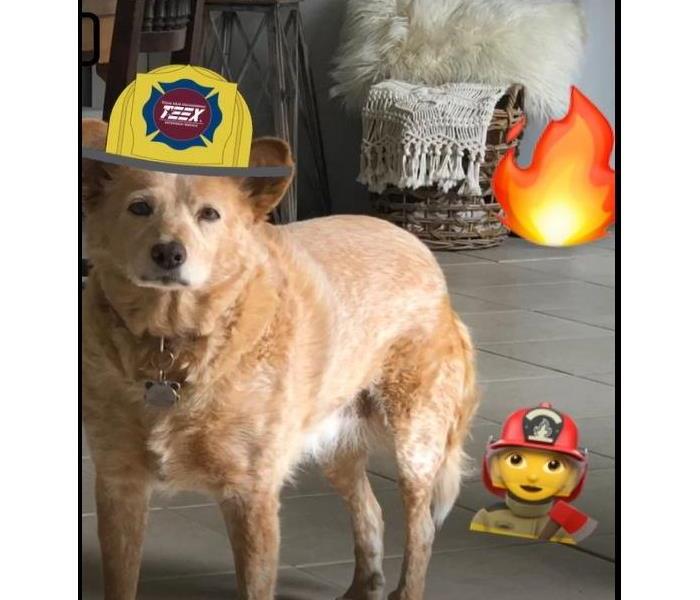 SERVPRO has prepared Ellie our Cattle dog for any emergency!
SERVPRO has prepared Ellie our Cattle dog for any emergency!
With the threat of fires and earthquakes in the Riverside area its important not to forget our pets. Some families have to leave their pets behind because of how quickly many need to evacuate. This information from Ready.gov will help you prepare your pets.
Get Informed
- Know what disasters could affect your area, which could call for an evacuation and when to shelter in place.
- Keep a NOAA Weather Radio tuned to your local emergency station and monitor TV, radio and follow mobile alert and mobile warnings about severe weather in your area.
- Download the FEMA app and get weather alerts from the National Weather Service for up to five different locations anywhere in the United States.
Make a Plan
Remember, during a disaster what’s good for you is good for your pet, so get them ready today.
If you leave your pets behind, they may be lost, injured or worse. Never leave a pet chained outdoors. Plan options include:
- Create a buddy system in case you’re not home. Ask a trusted neighbor to check on your animals.
- Identify shelters. For public health reasons, many emergency shelters cannot accept pets.
- Locate boarding facilities or animal hospitals near your evacuation shelter.
- Consider an out-of-town friend or relative.
- Locate a veterinarian or animal hospital in the area where you may be seeking temporary shelter in case your pet needs medical care. Add the contact information to your emergency kit.
- Have your pet microchipped and make sure that you not only keep your address and phone number up-to-date, but that you also include contact info for an emergency contact outside of your immediate area.
- Call your local emergency management office, animal shelter or animal control office to get advice and information.
- If you are unable to return to your home right away, you may need to board your pet. Find out where pet boarding facilities are located.
- Most boarding kennels, veterinarians and animal shelters will need your pet's medical records to make sure all vaccinations are current.
- If you have no alternative but to leave your pet at home, there are some precautions you must take, but remember that leaving your pet at home alone can place your animal in great danger!
Tips for Large Animals
If you have large animals such as horses, cattle, sheep, goats or pigs on your property, be sure to prepare before a disaster.
- Ensure all animals have some form of identification.
- Evacuate animals whenever possible. Map out primary and secondary routes in advance.
- Make available vehicles and trailers needed for transporting and supporting each type of animal. Also make available experienced handlers and drivers.
- Ensure destinations have food, water, veterinary care and handling equipment.
- If evacuation is not possible, animal owners must decide whether to move large animals to shelter or turn them outside.
Take extra time to observe livestock, looking for early signs of disease and injury. Severe cold-weather injuries or death primarily occur in the very young or in animals that are already debilitated.
Animals suffering from frostbite don’t exhibit pain. It may be up to two weeks before the injury becomes evident as the damaged tissue starts to slough away. At that point, the injury should be treated as an open wound and a veterinarian should be consulted.
Make sure your livestock has the following to help prevent cold-weather problems:
- Plenty of dry bedding to insulate vulnerable udders, genitals and legs from the frozen ground and frigid winds.
- Windbreaks to keep animals safe from frigid conditions.
- Plenty of food and water.
Build a Kit
Include basic survival items and items to keep your pet happy and comfortable. Start with this list or download Preparing Makes Sense for Pet Owners-Emergency Preparedness Pet Kit List (PDF) to find out exactly what items your pet needs to be Ready.
Your kit should include:
- Food (at least a three day supply in an airtight, waterproof container)
- Water (at least three days of water specifically for your pets)
- Medicines
- Medical records, proof of vaccinations, registration and adoption documents (talk to your veterinarian about microchipping)
- First aid kit (cotton bandage rolls, bandage tape and scissors, antibiotic ointment, flea and tick prevention, latex gloves, isopropyl alcohol, saline solution and a pet first aid reference book)
- Collar or harness with ID tag, rabies tag and a leash
- Crate or pet carrier (a sturdy, safe crate or carrier large enough for your pet to stand, turn around and lie down)
- Sanitation needs (litter box and litter, newspapers, paper towels, plastic trash bags and household chlorine bleach)
- A picture of you and your pet together to prove ownership (add species, breed, age, sex, color and distinguishing characteristics)
- Familiar items (treats, toys and bedding can help reduce stress for your pet)
SERVPRO of West Riverside City urges pet owners to plan for your pets. Include them in your evacuation plan and know where to go and where pets can be taken.
SERVPRO has prepared Ellie our Cattle dog for any emergency!
Part II-National Non Profit Day August 17th: Project Boon
8/17/2020 (Permalink)
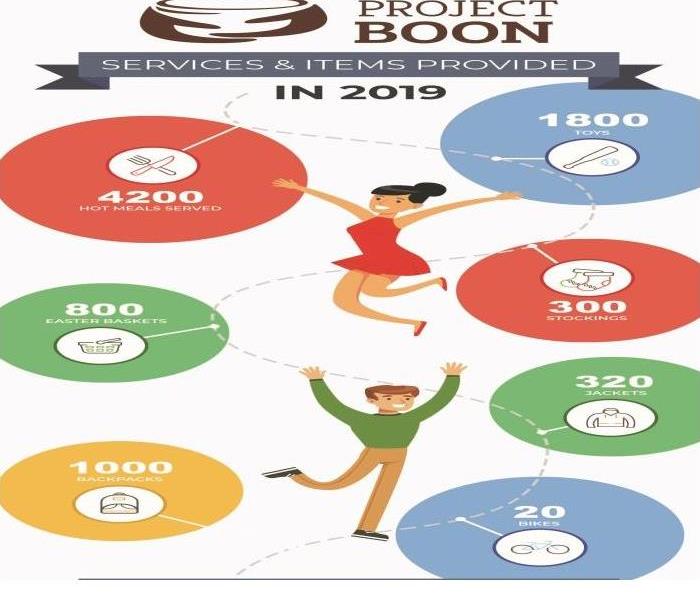 Project Boon operates events that bring together those in need, those willing to help, and the resources that make a difference.
Project Boon operates events that bring together those in need, those willing to help, and the resources that make a difference.
Project Boon amplifies the power of community through events that bring together committed individuals, organizations, and the underserved.
Their name, boon, means the general good created by meaningful, accessible action. It comes out of a simple idea: that we’re all connected, and we all have the ability to help one another.
About Project Boon
Project Boon, a 501(c)(3) nonprofit organization, is based in Rancho Cucamonga, California. As found on their website, They act as the organizing force behind a host of events every year, and while assisting the underserved is one of their primary achievements, they are also proud to:
- Show people the power they have to change the lives of others and how to use this knowledge.
- Offer a meaningful experience to the beneficiaries, participants, donors, and sponsors of events and create a lasting sense of community following these events.
- Engage professionals, executives, and companies, demonstrating the human impact of their business contributions.
Why Project Boon?
Project Boon operates events that bring together those in need, those willing to help, and the resources that make a difference.
When we were children, the neighborhood pulled together when a family down the street faced tough times. Our community made an immediate impact, and we knew the human connection.
Now, our mission is to help people connect with and rediscover the community to which we all belong—next door or a world away—by supporting our neighbors in need.
Board Member Matt Frechette
I wanted to highlight Matt Frechette who is one of the board members of Project Boon. He is one of the many members who help support and run the initiative of Project Boon. Matthew Frechette is the Executive Vice President & co-founder of MyTPG and the founder of Be Intentional Inc. He loves to help protect and grow small businesses and individuals who want to live a life of abundance. He does this by having fun, making a difference, and being intentional. He helps protect businesses from the state, the IRS, and themselves and helps promote individuals. Matthew believes culture is very important in the workplace, community, and home. He has supported multiple charities and been a part of many charity boards. He sees Project Boon as an organization of leaders intentionally having fun and making a difference.
Back Pack Event & Grocery Distribution
Project Boon recently hosted a Back Pack Event and Grocery Distribution in July.
They teamed up with The Hitch Burger Grill, Hillside Community Church, Firm Media, and OmniTrans to host a drive-thru back-to-school backpack event and grocery distribution for underserved families in Rancho Cucamonga and the surrounding areas. The event was held at The Hitch Burger Grill, in Rancho Cucamonga on July 26. Each family had the opportunity to receive fresh groceries, and school children were provided with backpacks filled with school supplies.
The event was on a first-come, first-serve, and they asked that attendees not line up early. Each family could receive one bag of groceries, and each child was given one filled backpack, with a maximum of two per car.
Project Boon received support for the effort by accepting donations of school supplies that could be dropped off at specific locations. Some of the items donated included:
- Backpacks for young boys and girls and older teens
- Pencils, pens, markers
- Pencil boxes
- Paper & notebooks
- Rulers
- Glue
- Binders & folders
One Business, Propel Chiropractic was able to contribute 90 filled backpacks to families in need!
Project Boon was able to accomplish this successful event with the help of many supporters. Because of the generosity of the community, they distributed backpacks to 600+ students and provided groceries to 300+ families. Cars lined up for miles, and they were able to serve everyone who joined. Check out their social media post within Facebook.
please visit the Project Boon website at www.projectboon.org for more information on how to donate or get involved in future events.
SERVPRO of West Riverside City encourages all to look to support a non-profit organization. We highlighted two with Clear the Shelters and Project Boon, but there are many nonprofit organizations. Through nonprofits, awareness, research, and aid reach the people who need it most. Nonprofits also produce tremendous benefits to their surrounding communities and the broader world. Take some time to learn more about nonprofits. Understanding that the funding for these organizations often satisfies more than the mission statement will help us see the benefits of supporting nonprofit organizations.
Part I Non Profit National Day- Clear the Shelters
8/12/2020 (Permalink)
 Visit the links within the article to locate a shelter dog that might fit your family! Let's Clear the Shelters Riverside!
Visit the links within the article to locate a shelter dog that might fit your family! Let's Clear the Shelters Riverside!
We observe Aug. 17 as National Nonprofit Day to acknowledge the positive impact that nonprofit organizations have on our local communities and around the world.
NonProfitPro gives 5 ways you can do this, here are two ways:
- Give Voice to Your Cause: Use the hashtag #nationalnonprofitday on your social media channels to be seen and create awareness for your organization among those who may not know about your cause, its goals and why it’s important to get involved.
- Thank Your Volunteers: To commemorate this special day of recognition, thank your volunteers for their support and call those who are regularly active and advocating on their behalf.
SERVPRO of West Riverside would like to highlight two non-profit organizations that Riverside Residents can participate within our own community. We will cover Part 1 today and Part 2 on August 17th
Part I -Animal Rescues
SERVPRO of West Riverside city is a huge supporter of dogs. Especially those in need of loving homes. Our shelters here in Riverside are full and many families are looking for fur babies and don't realize shelters are a great place to find that special pup. During current conditions with COVID-19, dogs can provide companionship and help relieve stress and anxiety.
Clear the Shelters
NBC4 and Telemundo 52 announced the return of their successful Clear The Shelters™ pet adoption drive from August 1-31, 2020. The virtual campaign will raise awareness about the importance of pet adoptions while practicing safe social distancing measures and feature online platforms to make it easy for people to adopt during the COVID-19 pandemic.
About Clear the Shelters
NBC and Telemundo owned stations are teaming up with hundreds of shelters across the country to host Clear the Shelters, a nationwide pet adoption drive in August 2020 that helps find loving homes for animals in need. More than 411,000 pets have found their forever homes since 2015.
You can check out local Riverside Shelters by clicking on this link:
Clear the Shelters
How to help Riverside County Animal Services
Riverside County Animal Services is joining forces again with NBC and Telemundo for the annual Clear the Shelters campaign. The Information is from their website:
Riverside County will be offering pets at a $20 adoption fee during the month of August at its two participating shelters in Jurupa Valley and Thousand Palms.
Due to the coronavirus pandemic, adoptions are still being handled by appointment only and pet meet-and-greet opportunities will be handled virtually when possible. The number to call for appointments is 951-358-7387. Visit www.rcdas.org, look through the available pets, make a note of the animal ID number, and give us a call at 951-358-7387 to schedule an adoption appointment.
This year’s Clear the Shelters for Riverside County Animal Services will not include a one-day mega event with hundreds of adopters, also due to COVID-19 and social distancing guidance from federal, state and local officials.
“It will be a much different Clear the Shelters for us and many others,” Animal Services Director Julie Bank said. “However, we appreciate NBC and Telemundo and the corporate sponsors for continuing in this mission to saving shelter pets.”
In the five years since Riverside County Animal Services has participated, thousands of pets were saved from its shelters and found homes with loving families. More than 410,000 pets found homes during the international campaign’s history.
“We’re living in a different world right now,” Bank said. “It’s a stressful time. We know, of course, animals provide us with great comfort. We believe the human-animal bonds are growing that much stronger during all the lockdowns and work-from-home periods."
For those that are unable to adopt, or already have a full house of pets, there is still a way to participate. NBC and Telemundo are teaming with GreaterGood.org, which has a website established to allow anyone to donate to shelters and rescue groups.
Locals can donate directly through Riverside County Animal Services’ website; here’s a link:
https://licensepet.com/wl3/don/rvsdwd/468
Mary S Roberts Pet Adoption
Cards for a Cause
When you purchase a box of cards through our Cards for a Cause fundraiser, you not only spread joy by letting friends and family know you are thinking of them with hand-written cards, but you are also helping the Mary S. Roberts Pet Adoption Center with our mission and allowing us to help many more homeless dogs and cats in our community.Each box of 30 greeting cards costs $31.50 (including tax). Holiday Card box includes 50 cards for $31.50.
- $13 from the cost of each box will directly benefit the Mary S. Roberts Pet Adoption Center.
- A purchase of one box of cards will cover the cost of microchipping two pets, helping them return home.
- A purchase of two boxes of cards covers the cost of rabies and other deadly disease prevention for one pet.
- And, a purchase of three boxes will spay or neuter one pet, helping to reduce pet overpopulation.
- Watch this video to see the cards in each box: https://youtu.be/yBRJi1bhnu8.
- Click here to see the Holiday Card box, which includes 50 cards for the same $31.50 price: https://youtu.be/MREG2XcfBBE.
- The fundraiser will close on August 15 at 11:59pm (PST).
- Free pick-up of your greeting cards will be available at Mary S. Roberts Pet Adoption Center upon arrival of our bulk order by approximately September 1.
- Alternately, priority mail shipping may be added to your card order for $12 per box. Cards will ship from the Mary S. Roberts Pet Adoption Center approximately 2 weeks after fundraiser closes, and tracking numbers will be provided at that time.
Don't have a need for cards right now? You may choose to make a donation below instead.
Make a Donation
Dates Cards are Available-
Cards are not being offered at this time, but check her website for other ways to donate.
- From Monday, 03 August 2020 12:00 AM to Saturday, 15 August 2020 12:03 AM
SERVPRO of West Riverside City Spotlights our Very Own Ellie on National Mutt Day!
7/29/2020 (Permalink)
 SERVPRO of West Riverside loves Ellie and her owner is happy she rescued a mix breed. She brought joy to their lives!
SERVPRO of West Riverside loves Ellie and her owner is happy she rescued a mix breed. She brought joy to their lives!
Unlike most of our doggy days, National Mutt Day, on July 31, focuses on the mixed breed dogs who sometimes get overlooked. This holiday inspires people to learn more about adopting one.
Dogs are special and there are many national holidays to prove it.
National Mutt Day also brings attention to the many great mixed breed dogs in need of homes. In fact, they benefit from the spotlight so much that we celebrate mixed breed dogs not just once, but twice a year! On both July 31 and December 2, join us in celebrating all the mutts and mixed breed dogs that make our lives so great.
In 2010 we rescued our Ellie from the IVHS in Pomona. It was December, the dog we went to pick up had been given to another person. My son, Josh, was devastated! Josh was in middle school, and I felt he was now old enough to help care for a dog. As he sobbed at the shelter for "Kelly" the 2yr old German Shepherd mix, he originally wanted, we attempted to console him. Staff members tried to find other dogs that he might like. One shelter employee thought maybe the puppies might do the trick. There was one puppy in a cage all by herself. A sign posted outside the cage read "aggressive", but how could a sweet little pup be aggressive?
We asked about this puppy, and asked if Josh could hold her. They opened the crate and handed over this precious, reddish and white speckled pup who looked like a little lion…. he instantly fell in love. She was listed as a Cattle dog mix. So I asked about the aggressive behavior noted on the cage. They said she was in a kennel with other puppies but she was biting them, so they separated her. I asked if she could be trained to address this behavior, their response was, "all dogs can be trained out of their bad behavior". This was enough to make me want her even more.
We took Ellie home in December after she was fixed, I was a little worried that she was too young, but they would not release her to us without this happening. We brought home this 10 week old puppy and named her Ellie. Here we were with an aggressive dog, who did not liked to be cuddled, she barked…a lot, and if you know cattle dogs, they are very high energy dogs that need a job to address that energy. Once all her shots were up to date, we enrolled her in obedience training at "It's a Dog's World" in Chino. They provided training in a park like setting, a more natural environment for a dog. They had us purchase a Gentle Leader Harness, which is an amazing way to leash your dog. After the course, we continued with socialization with other dogs and people.
As she matured, she grew into this beautiful unusual reddish color with white spots and speckles. She was no longer aggressive, and she allowed us to hug her, but only for a few minutes! We love her more than anything and we were so happy we spent the time and energy to get her to this amazing loyal creature.
If you are not sure about rescuing a dog especially not knowing the type of temperament they have, I hope this story motivates you. If you spend the time and work with them, I do believe you can train a dog out of any bad habits! You may need help from an obedience class, and it will be a lot of work, but nothing is better than the satisfaction of rescuing a dog in need of a loving home!
How to Observe National Mutt Day
- Adopt a mixed breed dog
There are lots of great dogs out there who lack a home just because they don't have the right pedigree. But you can do your part to change all that. Getting any dog is a big responsibility, but a mixed breed will likely be healthier, happier, better behaved — and live longer than a purebred of the same age.
- Donate to your local shelter
Not in the position to adopt a mutt? You can still help out your local shelter with a donation. Your money goes to things like food, toys and medicine. Every dollar counts, so you can really make a difference in the lives of all the dogs at the shelter.
- Volunteer to help out
If donations aren't your style, you can always volunteer. Shelters need volunteers to befriend the dogs, play with them and take them for walks. A few hours of your time can make a big difference in their happiness and happy dogs stand a better chance of getting adopted.
Visit your local shelter to see available adoptable dogs, or ones who need rescuing. Here are a few:
Riverside County of Animal Services
Pet Harbor
Mary S. Roberts Pet Adoption
Inland Valley Humane Society
What can Riverside Residents do During Drought Conditions
7/13/2020 (Permalink)
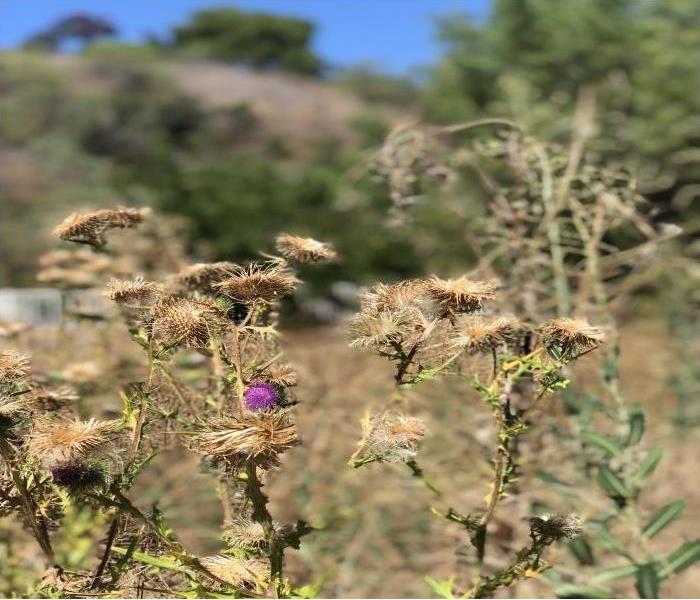 Southern California is known for limited rainfall causing drought conditions. In Riverside County, the dry conditions are cause for concern.
Southern California is known for limited rainfall causing drought conditions. In Riverside County, the dry conditions are cause for concern.
Nearly every part of the U.S. experiences periods of reduced rainfall.
Planning in advance for a drought can protect us in dry years. Southern California is especially known for limited rainfall causing drought conditions. In areas such as Riverside County, the dry conditions and warmer summer weather are also a cause for concern. Concerns range from threats of fire, watering your yard, and limiting water usage.
The best way to prepare for a drought is to conserve water. Make conserving water a part of your daily life. Ready.gov gives these great tips!
Indoor Water Conservation Tips Before a Drought
GENERAL
- Never pour water down the drain when there may be another use for it. For example, use it to water your indoor plants or garden.
- Fix dripping faucets by replacing washers. One drop per second wastes 2,700 gallons of water a year.
- Check all plumbing for leaks and have any leaks repaired by a plumber.
- Retrofit all household faucets by installing aerators with flow restrictors.
- Install an instant hot water heater on your sink.
- Insulate your water pipes to reduce heat loss and prevent them from breaking.
- Install a water-softening system only when the minerals in the water would damage your pipes. Turn the softener off while on vacation.
- Choose appliances that are more energy and water efficient.
BATHROOM
- Consider purchasing a low-volume toilet that uses less than half the water of older models. Note: In many areas, low-volume units are required by law.
- Install a toilet displacement device to cut down on the amount of water needed to flush. Place a one-gallon plastic jug of water into the tank to displace toilet flow. Make sure it does not interfere with the operating parts.
- Replace your shower-head with an ultra-low-flow version.
KITCHEN
- Instead of using the garbage disposal, throw food in the garbage or start a compost pile to dispose it.
Outdoor Water Conservation Tips Before a Drought
GENERAL
- Check your well pump periodically. If the automatic pump turns on and off while water is not being used, you have a leak.
- Plant native and/or drought-tolerant grasses, ground covers, shrubs and trees. Once established, your plants won't need as much watering. Group plants together based on similar water needs.
- Don't buy water toys that require a constant stream of water.
- Don't install ornamental water features (such as fountains) unless they use re-circulated water.
- Consider rainwater harvesting where practical.
- Contact your local water provider for information and assistance.
LAWN CARE
- Position sprinklers so water lands on the lawn and shrubs and not on paved areas.
- Repair sprinklers that spray a fine mist.
- Check sprinkler systems and timing devices regularly to be sure they operate properly.
- Raise the lawn mower blade to at least three inches or to its highest level. A higher cut encourages grass roots to grow deeper and holds soil moisture.
- Plant drought-resistant lawn seed. Reduce or eliminate lawn areas that are not used frequently.
- Don't over-fertilize your lawn. Applying fertilizer increases the need for water. Apply fertilizers that contain slow-release, water-insoluble forms of nitrogen.
- Choose a water-efficient irrigation system such as drip irrigation for your trees, shrubs and flowers.
- Turn irrigation down in fall and off in winter. Water manually in winter only if needed.
- Use mulch around trees and plants to retain moisture in the soil. Mulch also helps control weeds that compete with plants for water.
- Invest in a weather-based irrigation controller—or a smart controller. These devices will automatically adjust the watering time and frequency based on soil moisture, rain, wind, and evaporation and transpiration rates. Check with your local water agency to see if there is a rebate available for the purchase of a smart controller.
POOL
- Install a new water-saving pool filter. A single back flushing with a traditional filter uses 180 to 250 gallons of water.
- Cover pools and spas to reduce water evaporation.
SERVPRO of West Riverside City is available for any questions. Ready.gov is a source we use to help guide our neighbors through various situations. We especially use their storm, fire season, and flooding tips and much more. We can assist when you do sustain damage from these causes. Call us for a free inspection-951-351-8033
The New and Improved Payroll Protection Program
6/22/2020 (Permalink)
 Meet Shaila Chamberlain, a local Riverside CPA. She is very knowledgeable with small businesses!
Meet Shaila Chamberlain, a local Riverside CPA. She is very knowledgeable with small businesses!
Shaila Chamberlain is a local Riverside CPA. If you are a business professional, you want to know that your accountant has the expertise required to get the job done.
Shaila is part of Executive TEAM Referral, which SERVPRO of West Riverside is also a member of. She has a bachelor’s in accounting from Texas Tech University and a master’s in business administration from Pepperdine University. She has been working with small businesses for over 25 years and understand the unique challenges you face.
We wanted to spotlight Shaila and her newsletter. In a newsletter sent on June, 4, she discussed the topic, "The New and Improved Payroll Protection Program". The information was very informative, and she gave SERVPRO the okay to share it in our blog. In the same newsletter she highlighted SERVPRO of West Riverside City and our Certified: SERVPRO Cleaned service. Take a look:
Payroll Protection Program News (and a little personal commentary thrown in for good measure) – Many small businesses have taken on PPP loans – those SBA loans that were issued in a hurry over the last couple of months that were intended to ease the financial pain of government-mandated COVID-19 restrictions.
The hook of the PPP, was that businesses could receive 2.5 times their average 2019 payroll in the form of an SBA loan, and would have that loan forgiven if they spent at least 75% of the money on payroll and no more than 25% on rent and a few other small expenses during an 8 week period beginning one day after the loan was received. Like any major undertaking that is ill-conceived and poorly managed, it should come as no surprise that many business owners are finding the stipulations of the loan quite problematic.
For starters, the loans were issued based on 2.5 times an average monthly payroll. For our math-challenged friends in Congress, 2.5 times a monthly average payroll equates to about 10 weeks of payroll – Hard to spend 10 weeks of payroll in 8 weeks without some kind of “tweaking” along the way. Hence, the 25% that currently may go towards rent and utilities This is helpful for some businesses with high rent, low employee costs, but not all.
Secondly and more importantly, the loans are intended to keep people working. But this is at odds with near nation-wide orders to close businesses and shelter in place. How do you keep employees working, when business is closed?
Shut down, shelter-in-place and by the way, pay your employees at least as much as they made last year.
And just to keep things interesting, give said employees a big, fat bonus of $600 per week to take unemployment instead, requiring business owners to compete with the state and federal government to see how much we can pay people not to work. But I digress…
Read more
Certified: SERVPRO Cleaned
Can We Ever Be Clean Enough?
The good news -- business is slowly coming back! The bad news -- Covid-19 is still out there.
Getting back to business relies on getting customers back through your doors. And that only happens if customers feel safe and secure in your space.
Are you ready to help your customers and employees feel safe and communicate that you've chosen a higher standard of clean?
My friends at SERVPRO of West Riverside City are offering a defensive cleaning program that goes beyond janitorial - A proactive viral pathogen cleaning.
They will not only customize a cleaning plan to your specifications, they provide window emblems and signage to show your customers that you care about their health and safety. Click now to find out more.
Stay healthy. Stay safe. Stay positive.
The content herein is for informational purposes and does not constitute legal, financial or tax advice.
If you would like more information or to be added to her email distribution for her informative newsletters, feel free to reach out to her:
Shaila Chamberlain, CPA, CMA, MBA
Phone: 951.768.2969
Email: shaila@schamberlaincpa.com
Web: www.schamberlaincpa.com
Are You Feeling the Effects of Dry Hands?
5/6/2020 (Permalink)
 Along with hand soap keep hand lotion, or better yet, hand cream at every sink to prevent dry hands.
Along with hand soap keep hand lotion, or better yet, hand cream at every sink to prevent dry hands.
We hear of many complaining of dry cracked hands as a result of measures we need to take. We are urged to follow the direction from CDC and health officials who have emphasized that regular hand washing is imperative to helping curb the spread of COVID-19.
In this blog we will discuss the follow: When do I need to wash my hands? Tips from AAD on how to reduce risk of dry, chapped hands. And what types of hand soaps and hand moisturizers should we look for?
When do I need to wash my hands?
Handwashing throughout the day is important, but even more important during an outbreak. Always remember to wash your hands in these situations:
After returning from a public outing (grocery store, work, school, concert, sporting activity, hospital, nursing home, etc.).
Before leaving the bathroom — both at home and in public bathrooms.
After shaking hands during flu season and virus outbreaks.
Before, during, and after preparing food, especially raw food.
Before eating food.
Before and after caring for someone at home who is sick with symptoms of vomiting or diarrhea.
Before and after treating a cut or wound.
After changing diapers or cleaning up a child who has used the toilet.
After blowing your nose, coughing, or sneezing.
After touching an animal, animal feed, or animal waste.
After handling pet food or pet treats.
After touching garbage.
After putting on your shoes.
After using public computers, touching public tables and countertops, cash and coins, other people’s phones, etc.
Tips From AAD
Don’t let dry cracked skin stop you from washing your hands regularly or from washing them at least 20 seconds. We found tips from American Academy of Dermatology Association (AAD).
We naturally have oils and wax on the outer layer of our skin which shields and guards our skin. This maintains natural moisture. With the increase of washing our hands with hand soap and the use of alcohol based sanitizers, this causes a break down of this barrier causing dry, cracked hands.
To reduce your risk of dry, cracked skin from handwashing, follow these tips from board-certified dermatologists:
- Use lukewarm water
Not hot water, for at least 20 seconds, patting your hands dry with a towel.
- Moisturize immediately after washing your hands.
- Pat your hands dry, then rub a pea-sized amount of moisturizer over your hands.
- Use moisturizers with mineral oil or petrolatum.
- Look for ointments and creams — the ones you squeeze out of a tube — as these are more effective than products you pump out of a bottle.
- Choose fragrance- and dye-free moisturizers.
- These are less irritating for your skin.
- When soap and water aren’t available, use hand sanitizer.
- The CDC recommends using hand sanitizer with at least 60% alcohol. Since these can be drying, apply moisturizer after your hands dry.
- Continue washing your hands, even if they feel dry.
- Washing your hands can remove harmful bacteria and viruses.
Don’t believe everything you hear or see online. Using moisturizer after washing your hands does NOT negate your hand washing efforts, and there is NO evidence that using hand sanitizer makes you more vulnerable to infections or viruses.
What Types of hand soaps and hand creams should we look for? uclahealth.org helps us with some tips:
How should we wash our hands to avoid skin dryness?
Apply enough mild, fragrance-free soap to remove dirt, but avoid using so much that it creates a thick lather—this washes away natural oils. Wash with warm, not hot water, for at least 20 seconds, patting your hands dry with a towel. Once your hands are dry, apply a moisturizer immediately. Keep small travel sizes of creams in purse, gym bag, and at your work desk to make sure it is within reach.
Are there any ingredients people should avoid when their skin is chapped?
Products that contain fragrance can be irritating to chapped, sensitive skin. Creams and ointments are better than lotions. Hand sanitizers with too much alcohol can be drying to chapped skin. You can try a hand sanitizer with a moisturizing base, just know that it will not be as effective in killing viruses.
Are there common misconceptions about what to look for in hand creams?
Use hand ointment or cream instead of a lotion as these are more effective. Petrolatum (Vaseline) is still the most effective moisturizer out there.
Are there other treatments besides hands creams that people should consider?
At nighttime before going to bed, apply thick moisturizer and then cover with cotton gloves to increase absorption. Beauty product junkies can consider a moisturizing mask for hands. These glove-like masks are applied for 20 minutes, then washed off. Consider a humidifier at night—raising the humidity level in a room can help dry skin.
Again, health and safety are key during these pandemic times. Keep these tips in mind since this will likely be the "new norm" of regularly keeping our hands clean, and for minimum 20 seconds. I use petroleum jelly every night and first thing in the morning. I can see a difference taking these steps. Please be safe!
Tips for School Age Children while Riverside Schools Remain Closed
4/29/2020 (Permalink)
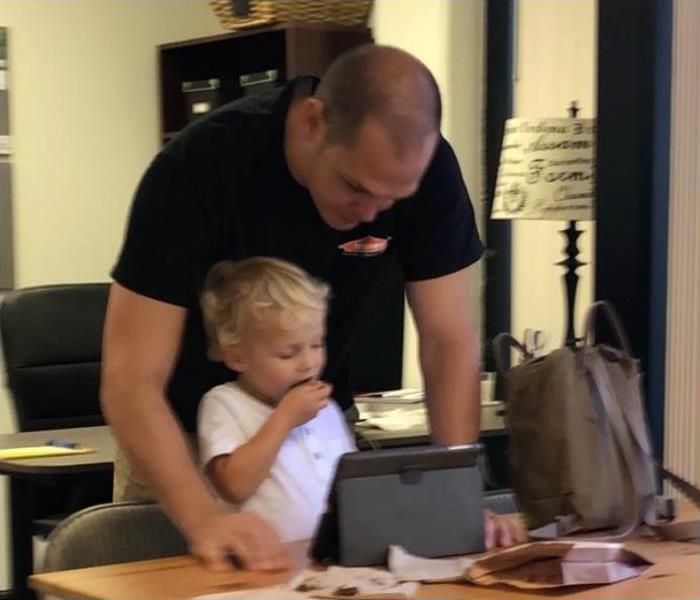 Take a deep breath. Know that we are all in this together. And together we will get through it.
Take a deep breath. Know that we are all in this together. And together we will get through it.
Having school aged children at home during the stay-at-home order can be challenging! But there are some things we can do to help keep children focused on online or virtual school and activities to keep them busy.
Keeping a routine is key
Healthy Children.org recommends the first step: Take a deep breath. Know that we are all in this together. And together we will get through it.
They also recommend to keep a routine. Children thrive with a routine. Daily expectations will keep them on track and focused. Create a daily schedule that can be placed on the refrigerator where they can see it each day. Be sure to include breaks from tele-work or schoolwork to relax and connect with each other. Here are some ideas to help you create a daily schedule:
- Wake up, get dressed and have breakfast at the normal time.
- Decide where everyone can do their work most effectively and without distractions.
- List the times for learning, exercise and breaks.
- For younger children, 20 minutes of class assignments followed by 10 minutes of physical activity might work well.
- Older children and teens may be able to focus on assignments for longer stretches, taking breaks between subjects.
- Include your hours as well, so your children know when the work day is done.
- Schedule time for nutritious lunches and snacks. Many schools are providing take-home school meal packages for students who need them.
- Don't forget afternoon breaks as well!
- Have dinner together as a family and discuss the day.
- Enjoy more family time in the evenings, playing, reading, watching a movie or exercising together.
- Stick with normal bedtime routines as much as possible during the week to make sure everyone gets enough sleep.
CDC recommends keeping children active:
Make physical activity intentional. If you don’t plan it, it probably won’t get done. Dedicate one-hour blocks of time for exercise each morning and afternoon, with ‘free exercise’ outside after ‘school’. For older children and teens, many coaches have been sending home training ideas. Be intentional about this and include it on their daily schedules.
- Encourage your child to play outdoors—it’s great for physical and mental health. Take a walk with your child or go on a bike ride.
- Use indoor activity breaks (like stretch breaks or dance breaks) throughout the day to help your child stay healthy and focused.
- Create Your Own Workout-Create your own “high intensity” workout with your family. Each person chooses their favorite moves, such as lunges, jumping jacks, squats, or even hops. Using a timer, do each workout move for 20 seconds, then take a 10-second break. Do four sets of each move, then take a 30 second break. This “interval training” is fun, fast-paced and really gets hearts pumping!
- Offer a challenge—i.e., challenge your kids to do a certain activity XX number of times, or challenge them to do X in XX number of minutes, with a reward for achieving this.
- Have a dance party
- Start planning your summer garden!
- Create an obstacle course with toys and games from your garage.
- If they play instruments, have them learn new songs.
CDC recommends helping your child stay socially connected
- Reach out to friends and family via phone or video chats.
- Write cards or letters to family members they may not be able to visit.
- Families can connect with Jackbox TV, for great family games.
Players play using their phones, tablets, or even computers as controllers – making it the perfect easy-in entertainment piece for your next game night or party. It can be displayed using Zoom to play with others outside their home.
- Create a scavenger hunt. This can be done several ways. Have neighbors place certain items on their windows for kids to find. You can easily create one in your back yard. It can also be played on Zoom, where a list of items will be called out. Kids have 2 minutes to locate the item in their home… the person with the most items collected from the list is the winner!
- Make dinner as a family; find recipes and tips for cooking with children safely on the Cooking with Kids webpage.
Parents can be creative and be flexible. You have to find a balance that works for your family. The goal should be to stay sane and stay safe.
Twelve Things You Can Do to Prepare for Spring
4/15/2020 (Permalink)
 Ready to prepare your Riverside home for Spring? These steps can help prevent future issues!
Ready to prepare your Riverside home for Spring? These steps can help prevent future issues!
Done with Winter? Are your Ready to Prep for Spring?
Here are 12 things you can do to prepare your Riverside home.
Clean your rain gutters.
Wind, animals, and gravity bring sticks, leaves, and other organic matter into your rain gutters, and chances are yours have accumulated their share of detritus over the winter. That's bad news for your home: When downspouts are clogged, rainwater can spill out of your gutters and around the perimeter of your house, putting it at risk for leaks and flooding. Get ready for spring showers by removing the mess from your gutters to ensure that the water will flow freely. Change filters.
To maintain optimal air quality in your home, it’s a good idea to replace your HVAC system's air filter seasonally as well as the filter in your kitchen range hood. While you're at it, consider changing the filters in your water purification system. Depending on your water, you might not need to change these as often as your HVAC filters, but it's not a bad idea to check them now. So, go ahead and welcome spring with new filters all around to keep your home clean and fresh, and your appliances in good working order. Need help ? See what SERVPRO of West Riverside City can do to help with our Air Duct and HVAC Cleaning Services.Check vents.
It’s a good time to check any vents along the foundation or in the attic. Look for missing or damaged screens, debris, signs of insect or rodent infestation, or other issues, and correct them before they have a chance to become bigger problems later in the season.Service the Lawn Mower.
Get your lawn mower ready for the season with a tune-up. If you didn’t do it in the fall, now’s the time to drain and replace oil, sharpen the blades, remove caked-on grass and mud, and lubricate moving parts.Prep the gas grill.
After a long winter spent cooped up indoors, you're probably eager for a sunny day and a burger hot off the grill. Get your outdoor cooking station ready for spring by scraping away any rust spots that developed over the winter, cleaning the grill inside and out, and checking the fuel tank hose for damage.Clean Backyard Furniture
As the weather warms up, outdoor entertaining may be just around the corner. Prepare for warmer days ahead by thoroughly hosing down all backyard furniture—chairs, tables, and lounge chairs—wiping away cobwebs, and bringing outdoor chair cushions out of winter storage.Pamper the Lawn
Once the danger of frost has passed and your grass starts to come out of winter dormancy, it’s time to jump-start your spring lawn-care routine. Address winter damage to your turf by seeding bare patches—although if you do reseed at this time of year, you should avoid spring applications of chemical weed or crabgrass treatments, which can harm new grass. Then get a head start on weed prevention by manually removing broad-leaf weeds before they have a chance to multiply. For cool-season grasses, spread a light application of fertilizer in early spring; for warm-season grasses, fertilization can wait until late spring or early summer.Groom Shrubs and Trees
Winter storms can be hard on your landscaping, resulting in broken tree limbs, ragged shrubs, and a garden full of organic debris. Get your yard ready for spring by removing broken or damaged branches, pruning summer-blooming trees and shrubs like butterfly bush and crepe myrtle, and raking up fallen leaves. For information on our Storm Damage services, click here.Check the Roof
Take advantage of the sun’s return to check your roof for cracked or missing shingles or tiles, and examine flashing around vents and the chimney for damage. While you’re at it, have the chimney cleaned and inspected by a professional.Plant Bulbs
Spring is the ideal time to plant summer-blooming flowers, which include beauties like dahlias and gladioli. Go ahead and get them into the ground as soon as the danger of frost has passed.Clean Windows
Winter storms and rain can leave your windows streaked and dirty. Improve your view of mellower weather and let more sun into the house by cleaning windows, both inside and out. Storm Damage ? Click here.Test Alarms
Let the change of season be your reminder to test all smoke alarms and carbon monoxide detectors for proper functioning. Change batteries if necessary. Alarms can malfunction as they age, so if yours are older than seven years, consider replacing them.Happy Spring, Riverside! In need of SERVPRO of West Riverside City services? Questions? Visit our website or call us at - 951-351-8033
Stay Healthy: 6 Tips for Avoiding Cold and Flu
4/13/2020 (Permalink)
 To completely get rid of viruses from your skin, you need to scrub hard for 20 seconds or more.
To completely get rid of viruses from your skin, you need to scrub hard for 20 seconds or more.
People who are exposed to cold and flu germs every day.
Doctors, flight attendants, teachers -- know a thing or two about how to stay healthy when everyone around them is sick. Their suggestions can help you, too.
Get a flu shot. It's the No. 1 thing you can do to prevent the flu.
Wash your hands -- a lot. No matter what line of work you’re in, if you come in contact with people who are contagious, you have to wash your hands over and over, says Alan Pocinki, MD. Pocinki practices internal medicine at the George Washington University Hospital in Washington, DC.
“Wash your hands as much as you can stand, and then some more -- especially after wrapping up a visit with someone who’s sick,” Pocinki says.
It sounds so simple, but soap and water are the constant companions of doctors and nurses. To completely get rid of viruses from your skin, you need to scrub hard for 20 seconds or more. A good way to time yourself is to sing "Happy Birthday" twice while scrubbing the backs of your hands, between your fingers, and under your nails. It doesn't matter if the water's hot or cold -- the very act of scrubbing will physically remove the germs.
Use alcohol-based hand sanitizer. If you can’t get to soap and water, sanitizer can kill cold and flu germs.
Avoid getting close to people who are sick. For example, don't shake hands.
“Doctors tend to be very cautious about hand shaking,” says Terri Remy, MD, medical director of Medical Associates at Beauregard in Alexandria, VA. “Just explain, ‘To keep transmission of colds and flu down, I’m not shaking hands. But hello! Nice to meet you!’ They understand.”
Keep your surroundings clean. Arlington, VA, massage therapist Amanda Long asks clients to stay home if they feel bad. But to be safe, she sanitizes doorknobs and light switches between sessions. It's a practice she swears by.
“My hyper-vigilance has paid off,” Long says. “I was sick more often when I worked in an office, where people pawed into shared candy dishes and generally just mingled in a crowded space without much attention to germs. Now that I don't have sick days, I don't get paid if I don't work. And I know my job is to heal, not pass on a cold or the flu.”
Beth Geoghegan, a paramedic in South Florida, says she starts her day by cleaning her work space with virus-and-germ-killing soaps.
“It may sound like overkill, but it’s not -- it’s awareness,” she says. “It’s a matter of looking at your environment and thinking, 'What could be contaminated?' All it takes is a tiny droplet. What could have a droplet on it? And I know someone was in my ambulance for 12 hours before I got there -- both patients and other paramedics. It may already look clean, but it might not be.”
It’s also a matter of context. When Geoghegan gets home from a shift where nothing much happened, she launches into her normal activities. If it’s been a day filled with sick patients, she follows a different routine.
“If I saw 10 patients today, and eight had flu symptoms, I’m likely to take my uniform off the minute I get home, put it in the wash, and get right in the shower. Because you just never know,” she says.
Keep up a healthy lifestyle. It's important to look after your own health, says Ardis Dee Hoven, MD, an internal medicine and infectious disease specialist in Lexington, KY.
“Do all the things we all should be doing on a daily basis anyway,” Hoven says. “Get adequate rest -- which people underestimate -- get good nutrition, don’t smoke, and keep your allergies controlled, because if they’re out of control, then your upper respiratory tree is already inflamed, which sets it up to more easily acquire a virus.”
Riverside, Are you Traveling for the Holidays? Here are Some Tips
11/27/2019 (Permalink)
With the holidays in full effect, it’s important to note safe travel practices before heading out on the road this year. Below you’ll find ways to help ensure a safe departure this holiday season - Read on to learn more!
If you are traveling during the holiday season, don’t let the stress of the hustle and bustle get you down. Realize ahead of time that there are millions of others that are also traveling and take steps to help cope with the situations that may arise due to the busy holiday traveling season. Travelchannel.com has provided the following tips to help you survive and calmly get to your destination.
HOLIDAY TRAVEL TIPS
- Do Your Research: Plan alternative routes when traffic gets overwhelming. Maybe there is a more scenic route that might take a little longer but has less traffic. When flying, be sure to check the airline’s restrictions ahead of time. Know the fees for carry-on luggage and checked bags.
- Stay Connected: Load your smartphone with all the latest travel apps before leaving home. There are apps to provide updates on flights, airport lines, cheapest gas, cleanest bathrooms, etc. You name it and there’s probably an app for that!
- Pack Light: If possible, avoid checking bags at the airport altogether.
- Pack Earplugs: The best way to escape stressful surroundings is to escape to a quiet place. Pack earplugs to turn down the crying babies, loud music, or loud talker sitting in the next aisle!
- Pack Snacks & Drinks: It’s more difficult to remain calm and make good decisions when you are hungry and your belly is growling. Always have snacks handy for when the need arises.
- Ship the Gifts or Give Gift Cards: For lighter travel, ship your gifts ahead of time or give gift cards.
- Travel on Off-Peak Days: The day before the holiday is always the most highly traveled. Try traveling on the actual holiday to avoid crowds and traffic.
- Travel Early or Late in the Day: Flights that leave early in the day are on-time more often. And avoid heavier traffic on the highways by traveling by car through the night.
Busy holiday travel is much easier to cope with if it is expected and planned for accordingly. While the hectic crowds and stress may not be completely avoided, one can definitely overcome the challenges by considering these tips when planning travel.
Driving long distance to visit family?
With the holidays in full effect, it’s important to note safe travel practices before heading out on the road this year. Below you’ll find ways to help ensure a safe departure this holiday season - Read on to learn more!
Prepare your Vehicle for Long DistanceCheck your wipers and fluids. Have your radiator and cooling system serviced. Simple maintenance can prevent many of the problems that strand motorists on the side of the road.
Plan AheadBefore you get on a highway, know your exit by name and number, and watch the signs as you near the off-ramp. Drivers making unexpected lane changes to exit often cause accidents.
Do not cut in front of large trucksRemember that trucks are heavier and take longer to make a complete stop, so avoid cutting quickly in front of them.
Beware of truck blind spotsWhen sharing the road with large trucks, be aware of their blind spots. If you can't see the truck driver in his or her mirrors, then the truck driver can't see you.
Check your emergency kit. Contents should include a battery-powered radio, flashlight, blanket, jumper cables, fire extinguisher, first aid kit, bottled water, non-perishable foods, maps, tire-repair kit and flares.Keep your eyes on the road Distracted driving is a major cause of traffic accidents. Even just two seconds of distraction time doubles the chances of an accident. Use your cell phone when stopped and never text while driving.
Leave early and avoid risks Leave early so you won't be anxious about arriving late and to accommodate delays. Road conditions may change due to inclement weather or traffic congestion.
Avoid extreme weather conditionsIce, hail and snow make roads difficult to travel. Try to avoid driving through extreme weather conditions, and travel during daylight.
Remove ice and snow from your vehicleClear snow from your windows and roof to ensure that you have maximum visibility and are not creating a hazard for the vehicle behind you. Don't allow ice and snow to create additional blind spots on your vehicle.
Beware of the vehicle in front of youLeave extra room between you and the vehicle in front so you can avoid snow and ice blowing onto your windshield or maneuver around patches of ice.
Slow downWith the extra highway congestion due to holiday travel, speeding becomes even more dangerous. Allow plenty of space cushion and reduce your speed.
Buckle upSafety belts reduce the risk of fatal injury by 45 percent and are a simple way to increase your safety on the road.
*Information courtesy of the American Trucking Associations
Will you be Frying a Turkey or Roasting one in your Riverside Home?
11/25/2019 (Permalink)
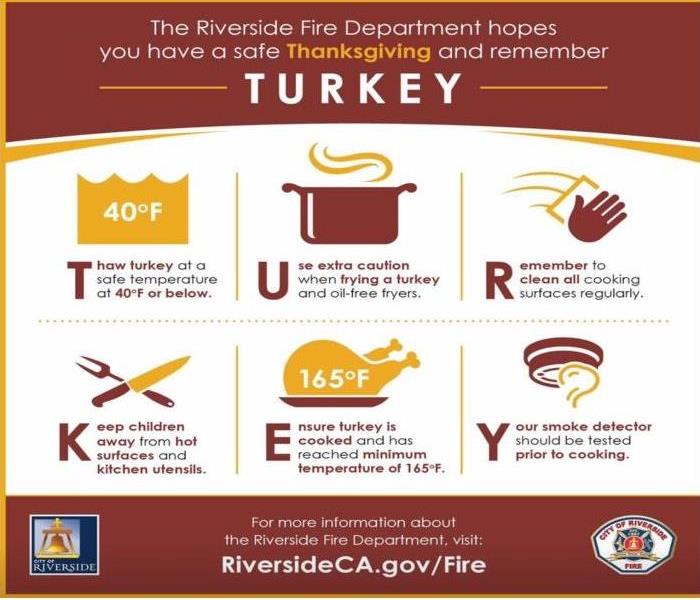 6 Tips from our Riverside Fire Department
6 Tips from our Riverside Fire Department
Riverside families will come together this holiday season. Avoid tragic fires with these cooking tips.
Many families come together over the Holidays for their favorite turkey dinner. It's also a time where family members may want to join in the food preparation so fire safety is important. With the speed of deep-frying a turkey, the irresistible flavor, and juiciness that results, turkey frying has become a Thanksgiving tradition for some. But turkey fryers have the potential to cause fire and serious injury, which is why organizations like Underwriters Laboratories and the National Fire Protection Association advises against using them. If you plan to deep-fry your holiday bird, be sure you know how to safely use the fryer, and take these precautions to protect yourself, your guests and your home.
Many first-timers fill the fryer with too much oil or attempt to fry a turkey that isn't entirely thawed. Both mistakes can cause serious fires. U.S. fire departments respond to more than 1,000 fires each year in which a deep-fryer is involved.
Tips to help prevent deep fried turkey accidents
- Keep outdoor fryers off decks, out of garages and a safe distance away from trees and other structures.
- Make sure the turkey is thawed and dry before cooking. Ice or water that mixes into the hot oil can cause flare-ups.
- Watch the weather. Never operate a fryer outdoors in the rain.
- Place the fryer on a level surface and avoid moving it once it's in use.
- Leave 2 feet between the tank and the burner when using a propane-powered fryer.
- Follow the manufacturer's instructions to avoid overfilling. Oil can ignite when it makes contact with the burner.
- Choose a smaller turkey for frying. A bird that's 8 to 10 pounds is best; pass on turkeys over 12 pounds.
- Never leave fryers unattended.
- Purchase a fryer with temperature controls and watch the oil temperature carefully. Cooking oil that is heated beyond its smoke point can catch fire. If you notice the oil is smoking, turn the fryer off.
- Turn off the burner before lowering the turkey into the oil. Once the turkey is submerged, turn the burner on.
- Wear goggles to shield your eyes, use oven mitts to protect your hands and arms and keep an "ABC" or grease-rated fire extinguisher close by. Do not to use water or a garden hose on a fire related to Turkey Fryers.
- Skip the stuffing when frying turkey and avoid water-based marinades.
- Keep children and pets away from the fryer at all times.
- Once finished, carefully remove the pot from the burner, place it on a level surface and cover to let the oil cool overnight before disposing.
- Opt for an oil-less fryer. This uses infrared heat, rather than oil, to cook the turkey.
If you are cooking in the kitchen
BE PROACTIVE
- Test the batteries in your smoke alarms. Press the test button on your units to make sure they work.
- Prevent fires by making sure your oven and stovetop are clean and free of grease and dust.
BE ATTENTIVE IN THE KITCHEN
In 2015, U.S. fire departments responded to an estimated 1,760 home cooking fires on Thanksgiving. Unattended cooking was by far the leading contributing factor in cooking fires and fire deaths, and cooking equipment was involved in nearly half (48 percent) of all reported home fires. Says ohsonline.com
- Stay in the kitchen when cooking on the stovetop and keep an eye on the food.
- Stay in the home when cooking your turkey as well, and check on it often.
- If you must step away from your cooking, set a kitchen timer so you don’t get distracted by guests.
- Keep children at least three feet away from the stove, oven, hot food and liquids. Steam or splash from vegetables, gravy, or coffee could cause serious burns.
- Keep items that can catch fire, such as oven mitts, wooden utensils, and towels, away from the cooking area.
- Make sure the floor is clear of tripping hazards such as children, toys, bags, or pets that could cause you to fall.
- Keep knives out of the reach of children.
- Turn pot and pan handles inward and away from the front or edge of the stove. If handles are turned outward, they could be jostled or knocked off the stove and spill, causing burns.
- Keep electric cords from appliances such as electric knives or mixers from dangling off the counter in reach of a child.
Should something occur and a fire breaks out SERVPRO of West Riverside City will be on hand. We are ready to help, we are available during holidays. Call us so we can take the stress off your shoulders in order to get your home back, "Like it never even happened."
SERVPRO West Riverside City
951-351-8033
Riverside, How to Protect yourselves from IDENTITY THEFT AND INTERNET SCAMS
10/28/2019 (Permalink)
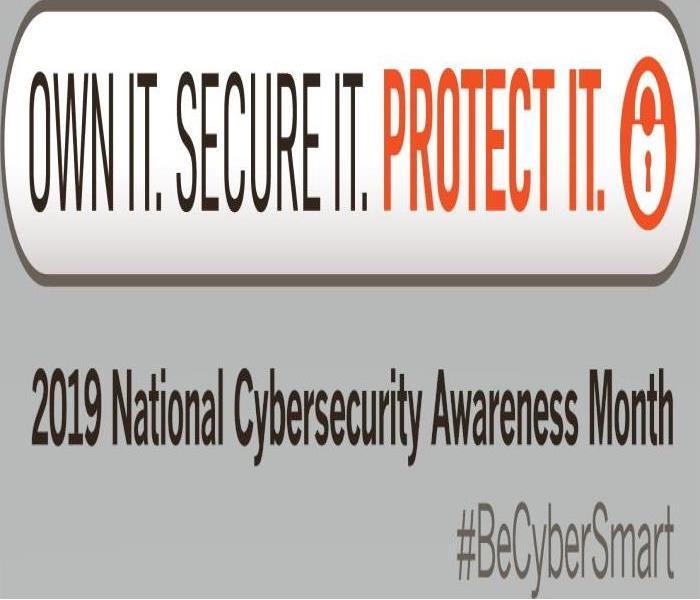 As technology continues to evolve, cybercriminals will use techniques to exploit technology to steal your identity, personal information, & money.
As technology continues to evolve, cybercriminals will use techniques to exploit technology to steal your identity, personal information, & money.
Today’s technology allows us to connect around the world, to bank and shop online, and to control our televisions, homes, and cars from our smartphones.
With this added convenience comes an increased risk of identity theft and Internet scams. #BeCyberSmart on the Internet—at home, at school, at work, on mobile devices, and on the go.
DID YOU KNOW?
- The total number of data breaches reported in 2018 decreased 23% from the total number of breaches reported in 2017, but the reported number of consumer records containing sensitive personally identifiable information (PII) exposed increased 126%. Identity Theft Resource Center, “2018 End-of-Year Data Breach Report”, 2018
- Credit card fraud tops the list of identity theft reports in 2018. The Federal Trade Commission (FTC) received more than 167,000 reports from people who said their information was misused on an existing account or to open a new credit card account. Federal Trade Commission, “Consumer Sentinel Network Data Book 2018”, 2019.
- Consumers reported $905 million in total fraud losses in 2017, a 21.6% increase over 2016. Experian, “Identify Theft Statistics”, 2019.
COMMON INTERNET SCAMS
As technology continues to evolve, cybercriminals will use more sophisticated techniques to exploit technology to steal your identity, personal information, and money. To protect yourself from online threats, you must know what to look for. According to the FTC, these are the top three kinds of threats reported in 2018:
- Identity theft is the illegal acquisition and use of someone else’s personal information to obtain money or credit. Signs of identity theft include bills for products or services you did not purchase, suspicious charges on your credit cards, or new accounts opened in your name that you did not authorize.
- Imposter scams occur when you receive an email or call from a person claiming to be a government official, family member, or friend requesting personal or financial information. For example, an imposter may contact you from the Social Security Administration informing you that your Social Security number (SSN) has been suspended, in hopes you will reveal your SSN or pay to have it reactivated.
- Debt Collection scams occur when criminals attempt to collect on a fraudulent debt. Signs the “debt collector” may be a scammer are requests to be paid by wire transfers or credit cards. In 2018 there was a spike in requests for gift cards and reloadable cards as well.
SIMPLE TIPS TO PROTECT IT.
- Double your login protection. Enable multi-factor authentication (MFA) to ensure that the only person who has access to your account is you. Use it for email, banking, social media, and any other service that requires logging in. If MFA is an option, enable it by using a trusted mobile device, such as your smartphone, an authenticator app, or a secure token—a small physical device that can hook onto your key ring. Read the Multi-Factor Authentication (MFA) How-to-Guide for more information.
- Shake up your password protocol. According to NIST guidance, you should consider using the longest password or passphrase permissible. Get creative and customize your standard password for different sites, which can prevent cyber criminals from gaining access to these accounts and protect you in the event of a breach. Use password managers to generate and remember different, complex passwords for each of your accounts. Read the Creating a Password Tip Sheet for more information.
- Be up to date. Keep your software updated to the latest version available. Maintain your security settings to keeping your information safe by turning on automatic updates so you don’t have to think about it, and set your security software to run regular scans.
PROTECT YOURSELF FROM ONLINE FRAUD
Stay Protected While Connected: The bottom line is that whenever you’re online, you’re vulnerable. If devices on your network are compromised for any reason, or if hackers break through an encrypted firewall, someone could be eavesdropping on you—even in your own home on encrypted Wi-Fi.
- Practice safe web surfing wherever you are by checking for the “green lock” or padlock icon in your browser bar—this signifies a secure connection. • When you find yourself out in the great “wild Wi-Fi West,” avoid free Internet access with no encryption. • If you do use an unsecured public access point, practice good Internet hygiene by avoiding sensitive activities (e.g., banking) that require passwords or credit cards. Your personal hotspot is often a safer alternative to free Wi-Fi. • Don’t reveal personally identifiable information such as your bank account number, SSN, or date of birth to unknown sources. • Type website URLs directly into the address bar instead of clicking on links or cutting and pasting from the email.
RESOURCES AVAILABLE TO YOU
If you discover that you have become a victim of cybercrime, immediately notify authorities to file a complaint. Keep and record all evidence of the incident and its suspected source. The list below outlines the government organizations that you can file a complaint with if you are a victim of cybercrime.
- FTC.gov: The FTC’s free, one-stop resource, www.IdentityTheft.gov can help you report and recover from identity theft. Report fraud to the FTC at ftc.gov/OnGuardOnline or www.ftc.gov/complaint
- US-CERT.gov: Report computer or network vulnerabilities to US-CERT via the hotline: 1-888-282-0870 or www.us-cert.gov. Forward phishing emails or websites to US-CERT at phishing- report@us-cert.gov.
- IC3.gov: If you are a victim of online crime, file a complaint with the Internet Crime Complaint Center (IC3) at http://www.IC3.gov.
- SSA.gov: If you believe someone is using your SSN, contact the Social Security Administration’s fraud hotline at 1-800-269-0271.
National Cybersecurity Awareness month-Riverside are you Aware?
10/21/2019 (Permalink)
 There are many ways to protect ourselves from cyber attacks. Internet of Things and Online Privacy are two areas we can focus on.
There are many ways to protect ourselves from cyber attacks. Internet of Things and Online Privacy are two areas we can focus on.
Cybersecurity is the practice of protecting systems, networks, and programs from digital attacks. These cyber attacks are usually aimed at accessing, changing, or destroying sensitive information; extorting money from users; or interrupting normal business processes.
Implementing effective cybersecurity measures is particularly challenging today because there are more devices than people, and attackers are becoming more innovative.
With the help from our friends at Homeland Security, SERVPRO of West Riverside City hopes our Riverside neighbors find these tips regarding Internet of Things and Online Privacy helpful.
INTERNET OF THINGS
Internet of Things (IoT) or smart devices refers to any object or device that is connected to the Internet. This rapidly expanding set of “things,” which can send and receive data, includes cars, appliances, smart watches, lighting, home assistants, home security, and more. #BeCyberSmart to connect with confidence and protect your interconnected world.
WHY SHOULD WE CARE?
• Cars, appliances, wearables, lighting, healthcare, and home security all contain sensing devices that can talk to another machine and trigger other actions. Examples include devices that direct your car to an open spot in a parking lot; mechanisms that control energy use in your home; and tools that track eating, sleeping, and exercise habits.
• New Internet-connected devices provide a level of convenience in our lives, but they require that we share more information than ever.
• The security of this information, and the security of these devices, is not always guaranteed. Once your device connects to the Internet, you and your device could potentially be vulnerable to all sorts of risks. • With more connected “things” entering our homes and our workplaces each day, it is important that everyone knows how to secure their digital lives.
SIMPLE TIPS TO OWN IT.
• Shake up your password protocol. Change your device’s factory security settings from the default password. This is one of the most important steps to take in the protection of IoT devices. According to NIST guidance, you should consider using the longest password or passphrase permissible. Get creative and create a unique password for your IoT devices. Read the Creating a Password Tip Sheet for more information.
• Keep tabs on your apps. Many connected appliances, toys, and devices are supported by a mobile application. Your mobile device could be filled with apps running in the background or using default permissions you never realized you approved— gathering your personal information without your knowledge while also putting your identity and privacy at risk. Check your app permissions and learn to just say “no” to privilege requests that don’t make sense. Only download apps from trusted vendors and sources.
• Secure your network. Properly secure the wireless network you use to connect Internet-enabled devices. Consider placing these devices on a separate and dedicated network. For more information on how you can secure your network, view the National Security Agency’s Cybersecurity Information page.
• If you connect, you must protect. Whether it’s your computer, smartphone, game device, or other network devices, the best defense is to stay on top of things by updating to the latest security software, web browser, and operating systems. If you have the option to enable automatic updates to defend against the latest risks, turn it on.
ONLINE PRIVACY
The Internet touches almost all aspects of our daily lives. We are able to shop, bank, connect with family and friends, and handle our medical records all online. These activities require you to provide personally identifiable information (PII) such as your name, date of birth, account numbers, passwords, and location information. #BeCyberSmart when sharing personal information online to reduce the risk of becoming a cyber crimes victim.
DID YOU KNOW?
• 64% of U.S. adults have noticed or been notified of a major data breach affecting their sensitive accounts or personal data. Smith, Aaron. “Americans and Cybersecurity.” Pew Research Center: Internet, Science & Tech. April 27, 2017.
• Roughly half of Americans (49%) feel that their personal information is less secure than it was five years ago. Ibid.
• 58% of Americans age 50 and older are more likely to feel that their personal information has become less safe in recent years: 58% of Americans in this age group express this opinion. Ibid.
• 69% of consumers believe companies are vulnerable to hacks and cyberattacks. PricewaterhouseCoopers. “Consumer Intelligence Series: Protect.me.” PwC. 2017.
SIMPLE TIPS TO OWN IT.
• Double your login protection. Enable multi-factor authentication (MFA) to ensure that the only person who has access to your account is you. Use it for email, banking, social media, and any other service that requires logging in. If MFA is an option, enable it by using a trusted mobile device, such as your smartphone, an authenticator app, or a secure token—a small physical device that can hook onto your key ring. Read the Multi-Factor Authentication (MFA) How-to-Guide for more information.
• Shake up your password protocol. According to NIST guidance, you should consider using the longest password or passphrase permissible. Get creative and customize your standard password for different sites, which can prevent cyber criminals from gaining access to these accounts and protect you in the event of a breach. Use password managers to generate and remember different, complex passwords for each of your accounts. Read the Creating a Password Tip Sheet for more information.
• Be up to date. Keep your software updated to the latest version available. Maintain your security settings to keeping your information safe by turning on automatic updates so you don’t have to think about it, and set your security software to run regular scans.
• If you connect, you must protect. Whether it’s your computer, smartphone, game device, or other network devices, the best defense against viruses and malware is to update to the latest security software, web browser, and operating systems. Sign up for automatic updates, if you can, and protect your devices with anti-virus software. Read the Phishing Tip Sheet for more information.
• Play hard to get with strangers. Cyber criminals use phishing tactics, hoping to fool their victims. If you’re unsure who an email is from—even if the details appear accurate— or if the email looks “phishy,” do not respond and do not click on any links or attachments found in that email. When available use the “junk” or “block” option to no longer receive messages from a particular sender.
• Never click and tell. Limit what information you post on social media—from personal addresses to where you like to grab coffee. What many people don’t realize is that these seemingly random details are all that criminals need to know to target you, your loved ones, and your physical belongings—online and in the real world. Keep Social Security numbers, account numbers, and passwords private, as well as specific information about yourself, such as your full name, address, birthday, and even vacation plans. Disable location services that allow anyone to see where you are—and where you aren’t—at any given time. Read the Social Media Cybersecurity Tip Sheet for more information.
• Keep tabs on your apps. Most connected appliances, toys, and devices are supported by a mobile application. Your mobile device could be filled with suspicious apps running in the background or using default permissions you never realized you approved—gathering your personal information without your knowledge while also putting your identity and privacy at risk. Check your app permissions and use the “rule of least privilege” to delete what you don’t need or no longer use. Learn to just say “no” to privilege requests that don’t make sense. Only download apps from trusted vendors and sources.
• Stay protected while connected. Before you connect to any public wireless hotspot—such as at an airport, hotel, or café—be sure to confirm the name of the network and exact login procedures with appropriate staff to ensure that the network is legitimate. If you do use an unsecured public access point, practice good Internet hygiene by avoiding sensitive activities (e.g., banking) that require passwords or credit cards. Your personal hotspot is often a safer alternative to free Wi-Fi. Only use sites that begin with “https://” when online shopping or banking.
Riverside Residents-SOCIAL MEDIA CYBERSECURITY AWARENESS
10/14/2019 (Permalink)
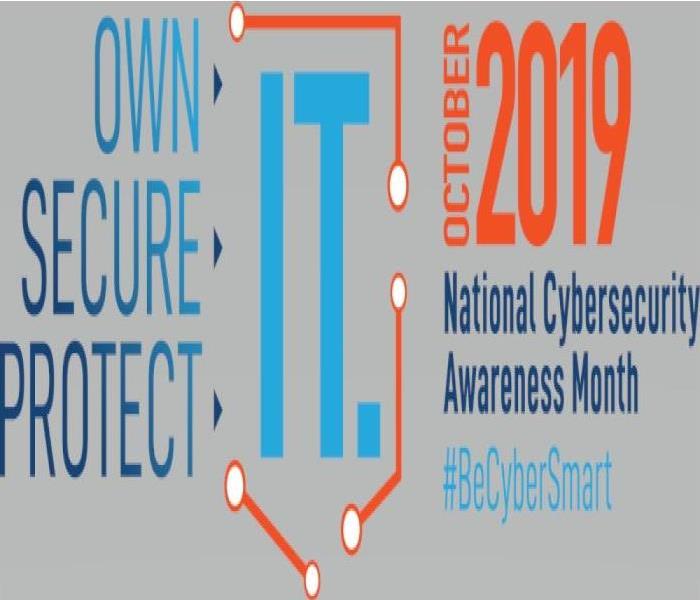 How can you be proactive to stay safe online and, “Own IT. Secure IT. Protect IT.”? #BeCyberSmart and take these steps to connect with confidence.
How can you be proactive to stay safe online and, “Own IT. Secure IT. Protect IT.”? #BeCyberSmart and take these steps to connect with confidence.
Now more than ever, consumers spend increasing amounts of time on the Internet. With every social media account you sign up for, every picture you post, and status you update, you are sharing information about yourself with the world. How can you be proactive to stay safe online and, “Own IT. Secure IT. Protect IT.”?
#BeCyberSmart and take these simple steps to connect with confidence and safely navigate the social media world.
DID YOU KNOW?
- 3.48 billion people worldwide now use social media worldwide. That’s an increase of 9% from 2018. Put another way: 45% of the total world population are using social networks.
From: Kemp, Simon. “Digital 2019: Global Digital Overview.” DataReportal. January 30, 2019. https://datareportal.com/reports/digital-2019
- Digital consumers spend nearly 2.5 hours on social networks and social messaging every day. Gwi.
“Latest 2019 Social Media User Trends Report.” GlobalWebIndex. 2019. https://www.globalwebindex.com/reports/social.
- 69% of U.S. adults use at least one social media site (New) berry, Christina. “130 Social Media Statistics That Matter to Marketers in 2019.”
Hootsuite Social Media Management. March 13, 2019. and the average American has 7.1 social media accounts.(Ibid.)
https://blog.hootsuite.com/social-media-statisticsfor-social-media-managers/.
SIMPLE TIPS TO OWN IT.
- Remember, there is no ‘Delete’ button on the Internet. Share with care, because even if you delete a post or picture from your profile seconds after posting it, chances are someone still saw it.
- Update your privacy settings. Set the privacy and security settings to your comfort level for information sharing. Disable geotagging, which allows anyone to see where you are—and where you aren’t—at any given time.
- Connect only with people you trust. While some social networks might seem safer for connecting because of the limited personal information shared through them, keep your connections to people you know and trust.
- Never click and tell. Limit what information you post on social media—from personal addresses to where you like to grab coffee. What many people don’t realize is that these seemingly random details are all that criminals need to know to target you, your loved ones, and your physical belongings—online and in the real world. Keep Social Security numbers, account numbers, and passwords private, as well as specific information about yourself, such as your full name, address, birthday, and even vacation plans. Disable location services that allow anyone to see where you are—and where you aren’t—at any given time. Read the Social Media Cybersecurity Tip Sheet for more information.
- Speak up if you’re uncomfortable. If a friend posts something about you that makes you uncomfortable or you think is inappropriate, let him or her know. Likewise, stay open-minded if a friend approaches you because something you’ve posted makes him or her uncomfortable. People have different tolerances for how much the world knows about them, and it is important to respect those differences. Don’t hesitate to report any instance of cyberbullying you see.
- Report suspicious or harassing activity. Work with your social media platform to report and possibly block harassing users. Report an incident if you’ve been a victim of cybercrime. Local and national authorities are ready to assist you.
SERVPRO of West Riverside City encourages our neighbors in Riverside to review more information regarding Cybersercurity on NICCS.
National Cybersecurity Awareness Month 2019
10/7/2019 (Permalink)
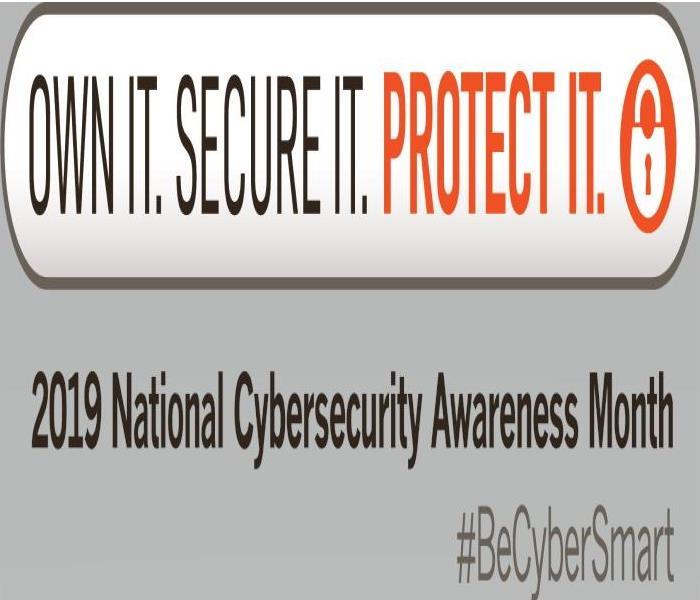 When you’re traveling— whether domestic or international—it is always important to practice safe online behavior and take proactive steps to secure In
When you’re traveling— whether domestic or international—it is always important to practice safe online behavior and take proactive steps to secure In
Held every October, National Cybersecurity Awareness Month (NCSAM) is a collaborative effort between government and industry to raise awareness about the importance of cybersecurity and to ensure that all Americans have the resources they need to be safer and more secure online.
NCSAM 2019 will emphasize personal accountability and stress the importance of taking proactive steps to enhance cybersecurity at home and in the workplace. This year’s overarching message – Own IT. Secure IT. Protect IT. – will focus on key areas including citizen privacy, consumer devices, and e-commerce security.
CYBERSECURITY WHILE TRAVELING
In a world where we are constantly connected, cybersecurity cannot be limited to the home or office. When you’re traveling— whether domestic or international—it is always important to practice safe online behavior and take proactive steps to secure Internet-enabled devices. The more we travel, the more we are at risk for cyberattacks. #BeCyberSmart and use these tips to connect with confidence while on the go.
SIMPLE TIPS TO OWN IT.
Before You Go
• If you connect, you must protect. Whether it’s your computer, smartphone, game device, or other network devices, the best defense against viruses and malware is to update to the latest security software, web browser, and operating systems. Sign up for automatic updates, if you can, and protect your devices with anti-virus software. Read the Phishing Tip Sheet for more information.
• Back up your information. Back up your contacts, financial data, photos, videos, and other mobile device data to another device or cloud service in case your device is compromised and you have to reset it to factory settings.
• Be up to date. Keep your software updated to the latest version available. Maintain your security settings to keeping your information safe by turning on automatic updates so you don’t have to think about it, and set your security software to run regular scans.
• Keep it locked. Lock your device when you are not using it. Even if you only step away for a few minutes, that is enough time for someone to steal or misuse your information. Set your devices to lock after a short time and use strong PINs and passwords. Read the Creating a Password Tip Sheet for more information.
• Double your login protection. Enable multi-factor authentication (MFA) to ensure that the only person who has access to your account is you. Use it for email, banking, social media, and any other service that requires logging in. If MFA is an option, enable it by using a trusted mobile device, such as your smartphone, an authenticator app, or a secure token—a small physical device that can hook onto your key ring. Read the Multi-Factor Authentication (MFA) How-to-Guide for more information.
During Your Trip
• Stop auto connecting. Some devices will automatically seek and connect to available wireless networks or Bluetooth devices. This instant connection opens the door for cyber criminals to remotely access your devices. Disable these features so that you actively choose when to connect to a safe network.
• Stay protected while connected. Before you connect to any public wireless hotspot—such as at an airport, hotel, or café—be sure to confirm the name of the network and exact login procedures with appropriate staff to ensure that the network is legitimate. If you do use an unsecured public access point, practice good Internet hygiene by avoiding sensitive activities (e.g., banking) that require passwords or credit cards. Your personal hotspot is often a safer alternative to free Wi-Fi. Only use sites that begin with “https://” when online shopping or banking.
• Play hard to get with strangers. Cyber criminals use phishing tactics, hoping to fool their victims. If you’re unsure who an email is from—even if the details appear accurate—or if the email looks “phishy,” do not respond and do not click on any links or attachments found in that email. When available use the “junk” or “block” option to no longer receive messages from a particular sender. Read the Phishing Tip Sheet for more information.
• Never click and tell. Limit what information you post on social media—from personal addresses to where you like to grab coffee. What many people don’t realize is that these seemingly random details are all that criminals need to know to target you, your loved ones, and your physical belongings—online and in the real world. Keep Social Security numbers, account numbers, and passwords private, as well as specific information about yourself, such as your full name, address, birthday, and even vacation plans. Disable location services that allow anyone to see where you are—and where you aren’t— at any given time. Read the Social Media Cybersecurity Tip Sheet for more information.
• Guard your mobile device. To prevent theft and unauthorized access or loss of sensitive information, never leave your equipment—including any USB or external storage devices—unattended in a public place. Keep your devices secured in taxis, at airports, on airplanes, and in your hotel room.
National Preparedness Month Week 3: Teach Your Youth to Prepare for Disasters Sept 15-21
9/16/2019 (Permalink)
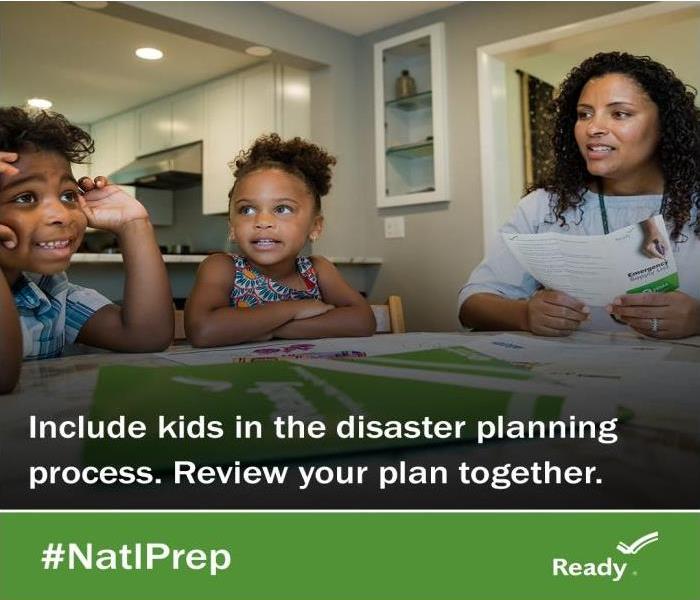 It's important to teach kids about disasters preparedness. Make it fun, have them help put together an emergency kit. "Be Prepared Not Scared".
It's important to teach kids about disasters preparedness. Make it fun, have them help put together an emergency kit. "Be Prepared Not Scared".
The phrase "The better you're prepared, the less you're scared" goes for kids as well as adults.
When talking to kids about disasters, it is important to teach them about disasters, without scaring them. It's a balancing act between the facts and potential impacts of a disaster and empowering them with actions they can take to be safe. Being open about what you are doing as a family to prepare before disasters happens is comforting. When possible, involve kids in activities like putting together the disaster supplies kit.
The best thing you can do for younger children is to create a safe environment around them. You can't really teach an infant or toddler about Drop Cover and Hold in an earthquake, but you can reduce the likelihood they will get hurt from falling book shelves, pictures and other furnishings around them. For more information on reducing earthquake hazards in your home visit our Prepare your Home page
As kids get older
For most kids, you can start introducing safety actions at about 4-years-old. Don't overwhelm them with too much information at once. Teach one safety action such as Drop, Cover and Hold, and follow up with actually doing it so they can demonstrate they understand. Practice with them until you are satisfied they know what to do. As kids get older, you can talk about how a disaster is something that could hurt people or cause damage. Explain that nature sometimes provides "too much of a good thing" -- fire, rain, and wind. Explain how important it is to make a Family Disaster Plan. Teach children:
How to call for helpWhen to call each emergency numberTo call the family contact if separatedTo keep personal identification information in their possession at all timesLet them help with testing smoke detectors or building the family kit. You can get them their own backpack and have them assemble a kit for themselves. When you involve your kids in getting your family ready, you are insuring they understand the family plan and are building life skills that will come in handy as they grow up!Be Prepared, Build a Kit
Being prepared for an emergency isn't just about staying safe during a disaster. It's about how to stay comfortable, clean, fed, and healthy afterwards – when a storm or disaster may have knocked out electricity.
If you lost power, how would you eat? The refrigerator can’t keep foods cold. The microwave can’t warm things up. You might not get clean water out of your faucets. How would you find out whether it was safe to play outside? Not from the TV or computer!
That’s why it’s important for families to work together to build an emergency kit before an emergency strikes. There should be enough food, water, clothing, and supplies to last for at least three days.
Here are some items you and your family will need:
Non-perishable food (such as dried fruit or peanut butter)First aid kitExtra batteriesMatches in a waterproof containerToothbrush, toothpaste, soapPaper plates, plastic cups and utensils, paper towelsWater – at least a gallon per person, per dayBattery-powered or hand-cranked radioSleeping bag or warm blanket for each personFlashlightsWhistle to signal for helpCan opener (manual)Local mapsPet suppliesBaby supplies (formula, diapers)Additional Emergency Supplies
Consider adding the following items to your emergency supply kit based on your individual needs:
Prescription medicationsNon-prescription medications such as pain relievers, anti-diarrhea medication, antacids or laxativesGlasses and contact lense solutionInfant formula, bottles, diapers, wipes, diaper rash creamPet food and extra water for your petCash or traveler's checksImportant family documents such as copies of insurance policies, identification and bank account records saved electronically or in a waterproof, portable containerSleeping bag or warm blanket for each personComplete change of clothing appropriate for your climate and sturdy shoesHousehold chlorine bleach and medicine dropper to disinfect waterFire extinguisherMatches in a waterproof containerFeminine supplies and personal hygiene itemsMess kits, paper cups, plates, paper towels and plastic utensilsPaper and pencilBooks, games, puzzles or other activities for childrenMaintaining Your Kit
After assembling your kit remember to maintain it so it’s ready when needed:
Keep canned food in a cool, dry placeStore boxed food in tightly closed plastic or metal containersReplace expired items as neededRe-think your needs every year and update your kit as your family’s needs change.Kit Storage Locations
Since you do not know where you will be when an emergency occurs, prepare supplies for home, work and vehicles.
Home: Keep this kit in a designated place and have it ready in case you have to leave your home quickly. Make sure all family members know where the kit is kept.Work: Be prepared to shelter at work for at least 24 hours. Your work kit should include food, water and other necessities like medicines, as well as comfortable walking shoes, stored in a “grab and go” case.Vehicle: In case you are stranded, keep a kit of emergency supplies in your car. SERVPRO of West Riverside city is local and available 24/7, keep our information in your emergency contact list. We are here to help!
SERVPRO Proudly Supports National Suicide Prevention Awareness Month
8/28/2019 (Permalink)
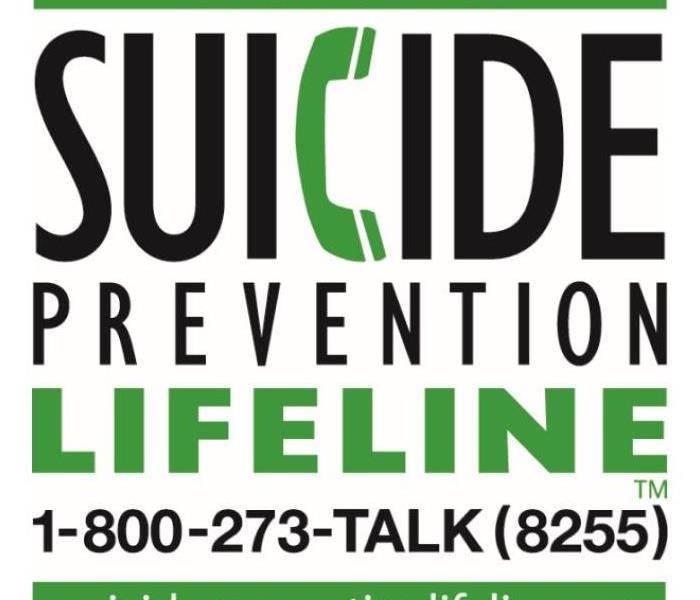 September is National Suicide Prevention Awareness Month. You can help by sharing information and offering resources to those affected by suicide.
September is National Suicide Prevention Awareness Month. You can help by sharing information and offering resources to those affected by suicide.
Suicide is a tragedy that can affect any individual, whether as a person struggling with suicidal idealization and thoughts or as one of a circle of family, friends, and community members who want to help.
Many resources are available year-round for both victims and their circles, but September is the month we refocus on the supports in our community. Suicide prevention is only effective if the information is made available and shared throughout the Riverside area, and we are reminded each September to do our part to make this happen.
Now is the time for all members of the community to come together to share information and offer resources to those affected by suicide. Connecting potential victims with treatment options and supporting survivors with the personal and practical services needed to begin the healing process are crucial components of a caring and effective response to these painful and traumatic events.
Victims and families deal with a broad array of issues in a suicide. Extending a hand to neighbors, friends, family, business partners, and others is the least our community can do to help. When the community comes together in an effort to conquer this challenging set of circumstances it gives cause for hope to those who are directly affected. We are honored to be part of a multifaceted team extending a hand to our neighbors experiencing this type of loss.
SERVPRO of West Riverside City offers compassionate and professional services if you are in need of assistance after a suicide-related tragedy. Our office staff, managers, and technicians are prompt, discreet, and sensitive as we help at this difficult time. Crew members assigned to your home or business train thoroughly in all aspects of trauma scene abatement, providing thorough cleanup always with the utmost respect for you, your family, and others impacted by the crisis.
Aug 26 National Dog Day, How Can Riverside Residents Help
8/26/2019 (Permalink)
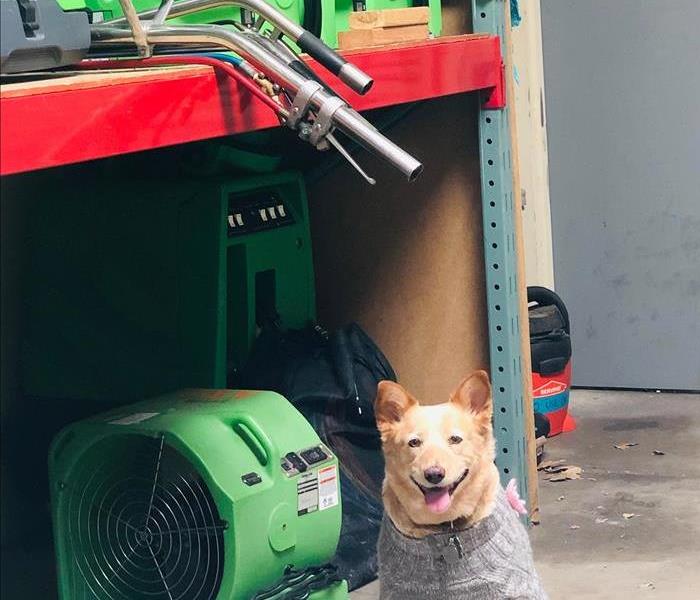 We Rescued Ellie when she was 9 weeks old, she was found roaming the streets by herself. Rescues are some of the best pets!!!
We Rescued Ellie when she was 9 weeks old, she was found roaming the streets by herself. Rescues are some of the best pets!!!
About National Dog Day, from our friends at NationalDogDay.com
National Dog Day has two goals: to honor dogs, and to rescue dogs from homelessness and abuse. It's an opportunity for us to recognize and appreciate the value and importance of dogs in our lives.
This day is intended to honor dogs for all that they do for us. In addition to giving love and companionship, dogs help us out in countless ways:
- They are watchdogs for our safety.
- They lead the blind.
- Dogs aid in search and rescue,
- They seek out bombs and drugs.
The second goal of National Dog Day is to rescue dogs in need. On occasion, dogs need us to save them from homelessness and abuse. The goal of the National Dog Day foundation is to rescue 10,000 dogs a year. Lend a hand to help a dog in need today, or any day.
Check out our local shelter in Riverside:
https://www.rcdas.org/
ADOPTION FEES
Dogs
Fees
0-15 Days
$105
16-30 Days
$55
31 Days and Over
$20
Senior Adoption Rates
50% Off
Active Duty and Veteran Adoption Rates
Free
Department of Animal Services Mission, Vision and Values
Mission
Working together to improve Riverside County for people and animals
Vision
Promoting an environment of responsible pet ownership through progressive animal welfare initiatives, community outreach, and humane education in a culture of compassion, creativity, and integrity.
Core Values
We believe the character of our organization is best reflected in the strong dedication of each of us to strive to meet the highest standards of performance and compassion on behalf of the animals and people we serve.
As stewards of those who cannot speak for themselves, we recognize society has entrusted us with a great responsibility. Our community's expectations and trust give us the courage to perform our duties with transparency, honor, empathy and compassion.
We meet this vision by our shared commitment to:
- Demonstrating respect, sensitivity and understanding toward all people and animals.
- Improving Riverside County through education, humane sheltering, responsible pet placement, progressive law enforcement, and reduction of pet overpopulation.
- Using adoption, education, and veterinary medical programs as an alternative to euthanasia.
- Seeking lifetime homes for the pets we place.
- Providing the tools, environment, and information to foster a safe and healthy workplace with an emphasis on teamwork.
- Collaborating to improve Riverside County for its people and animals.
National Dog Day celebrates all dogs, mixed breed and pure. Their mission is to help galvanize the public to recognize the number of dogs that need to be rescued each year and acknowledges family dogs and dogs that work selflessly each day to save lives, keep us safe and bring comfort.
Dogs are amazing, courageous, sensitive and sentient beings that deserve compassion and respect. Please consider bringing what was once considered "unwanted love", into your heart and home on National Dog Day!"
To see the dogs up for adoption at the Riverside Shelter click the link below:
https://www.rcdas.org/petharbor/secured_PetHarbAdoptSearch.html
NationalDogDay.com lists 20 ways to celebrate:
- Adopt a dog from your local shelter
- Have a safety check of your home to be sure it's safe for your dog and others
- Donate blankets, food and toys to animal welfare organization
- Organize a peaceful demonstration in front of your community pet store that sells puppies
- Write your congressman and ask that he/she support the ban on puppy mills and gas chambers in your state
- Sent a dog related gift to a friend or family member
- Have a National Dog Day party and invite your friends and their dogs
- Spend the day taking photos of your dog and then enter their photo contest
- Buy an official National Dog Day Tee and sport it proudly
- Assist and ill or elderly neighbor by walking their dog
- Have a portrait painted of your dog to suspend the fleeting magic of dogdom
- Buy your dog a fun new dog toy…or two…or five
- Give your dog some fun exercise by taking him/her to a doggy play resort
- Brush your dog to eliminate excess fur
- Give your dog a massage or holistic spa treatment
- Teach your dog a new trick
- Buy your dog a fashionable collar or leash
- Hire a professional pet photographer for a fun photo shoot
- Take your dog to the beach
- Say "Because Dogs" all day , every time someone says hello
SERVPRO of West Riverside City is a strong believer in rescuing dogs from our local shelters rather than shopping for one elsewhere. Our Mascot Ellie, a Cattle dog mix, was rescued from Inland Valley Humane Society. She has been a loyal, happy dog that we have owned for 8 years. She was found roaming the streets at just 8 weeks on her own. We fell in love with her when we first met her and new she would be a great addition to our family. She loves coming to work and is on her best behavior when in the office.
Back-to-School Tips for our Riverside Residents
8/15/2019 (Permalink)
 School is back in session, there things that parents can do for themselves and their kids to ensure a smooth transition into the school year!
School is back in session, there things that parents can do for themselves and their kids to ensure a smooth transition into the school year!
With a well-rounded summer vacation ending, parents spend a lot of time getting their kids ready for school. New school supplies, haircuts, and special end-of-summer outings all play into the back-to-school routine. There are some other things that parents can do for themselves and their kids to ensure a smooth transition into the school year, too. Take a look below at few ways to get this year off to a great start in your house.
Set up a bedtime and wake-up routine in advance. If possible, it’s best to establish bedtimes and wake-up times two weeks in advance of the start of school. By the time the first school bell rings, kids will already be on the right sleeping schedule and it will be one less worry for your family.
Get to know new teachers. There will be open houses, orientations, and other meet-and-greet options at the beginning of the school year, but none will give you the chance to spend some quality time getting to know your kids’ teachers. Try to find a few minutes before or after school to connect one-on-one with the teachers. At the very least, send an introductory email that includes how you can help during the school year, however big or small.
Plan healthy lunches and snacks. The better you plan out the meals in your home, the healthier choices you will make for your kids. When you pack protein-rich snacks and lunches, balanced with fruits, vegetables, and other wholesome items, you ensure that your children will have the energy and brainpower to make it through their school days.
Organize clothing. Of course you will need to donate or otherwise get rid of the clothing that your kids have outgrown, but you should also take the time to carefully organize what is left. From there, decide what items you may need more of before school begins.
Set up a staging area. Find a central spot to store everything related to school, including backpacks, upcoming outfits, and a dry erase calendar with family schedules. Try to keep this area free of clutter and other non-school items so that you can find what you need, when you need it—and quickly. Have the kids help you stock it with school-related items and keep it clean and functional. Find some inspiration here.
Update medical records. Most schools will let you know if your shot records are out of date, but why not go beyond that? Make sure teachers and administrators have a complete list of any medical concerns regarding your kids, including allergies. You will also want to be sure that all emergency contacts are up to date.
Talk to your kids about bullying. Research shows that one in three kids experience bullying at some point in their school career—and in the increasingly digital world, the consequences can be extreme. Make sure your kids understand the right way to treat their peers, and when to speak up if they see someone else being bullied. Also make sure they know when to come to you if they feel they are being bullied.
Ask your kids about their concerns. The start of school is exciting, but can also bring some anxiety—especially when it comes to the unknown. Take a few minutes to ask your kids what they are most looking forward to during the school year, and what things may be worrying them. By giving them a forum to express their concerns, you can help them work through any worries in advance of school starting and clear up any issues that could lead to a bumpy start to the year.
by SPARK
SERVPRO of West Riverside City also wants to remind Riverside residents that Safety Awareness is always important. Now, the kids may be plugging in flat irons and forget to turn them off. Some may be back onto the morning coffee, and leave the coffee pot powered on all day when they leave the house. Additionally, you may want to consider pulling out the cell phone charger from the wall when you are not charging the cell phone. Did you ever happen to feel how hot it gets plugged into the wall when it is not charging a cell phone? Also, please check smoke detector batteries, and have at least one extra set of batteries in the home--ready to go, so there is no "down time" without batteries in the smoke detector. Please have a family plan for emergency exit, and consider a minimum of two exits. Have all persons in the household agree to a designated meeting spot outside the home in advance.
Have a wonderful school year and don’t hesitate to contact SERVPRO of West Riverside if you need our help. You can reach us at 951-351-8033.
National CPR/AED Awareness Week
5/30/2019 (Permalink)
SERVPRO of West Riverside City would like to remind you that June 1- June 7 is National CPR and AED Awareness Week.
The resolution was created by the American Heart Association, along with the American Red Cross and the National Safety Council and was passed by congress in 2007.
Would you know what to do if someone needed help?
Every second counts in cardiac arrest. Sudden cardiac arrest claims thousands of lives every year. Knowing when and how to perform CPR (Cardiopulmonary resuscitation) and use an AED (Automated External Defibrillator) can make the difference between life and death for someone suffering from cardiac arrest. The Red Cross recommends that households, businesses and schools receive training in CPR and use of an AED. This training can give them the knowledge and confidence to respond during an emergency situation with the skills that can save a life. Check with your town or the American Heart Association today to sign up for a course.
Life can change in a matter of minutes which is why we know the best way to expect the unexpected is to be prepared. We think CPR and First Aid training is important in the work place for many reasons:
- Having trained employees can make a substantial difference in your ability to maintain a safe work environment. They will be able to respond more quickly and effectively when medical emergencies occur.
- This training and knowledge provides a sense of security and promotes a more confident work environment.
- As staff becomes more prepared and responsive – they also become more aware of their surroundings and more likely to spot potential hazards. This inspires a ‘safety culture’.
- 25% of all emergency room visits can be avoided with basic first aid and CPR certification.
- Safety precautions and preparedness applies to ANY industry of ANY size.
- There are many local resources that can help you get CPR and First Aid Certified such as The Red Cross
Statistics from our friends at HealthSafety.com
(SCA)
- Almost 300,000 casualties of out-of-hospital cardiac arrest are treated each year in the U.S.
- Less than eight percent of people who suffer cardiac arrest outside the hospital survive.
CPR
- Less than one-third of out-of-hospital sudden cardiac arrest casualties receive bystander CPR.
- Effective bystander CPR, provided immediately after sudden cardiac arrest, can double or triple a person’s chance of survival.
Automated External Defibrillators (AEDs)
- Unless CPR and defibrillation are provided within minutes of collapse, few attempts at resuscitation are successful.
- Even if CPR is performed, defibrillation with an AED is required to stop the abnormal rhythm and restore a normal heart rhythm.
- New technology has made AEDs simple and user-friendly. Clear audio and visual cues tell users what to do when using an AED and coach people through CPR. A shock is delivered only if the victim needs it.
From American Heart Association: Why Learn Hands-Only CPR?
Cardiac arrest – an electrical malfunction in the heart that causes an irregular heartbeat (arrhythmia) and disrupts the ?ow of blood to the brain, lungs and other organs – is a leading cause of death. Each year, more than 350,000 EMS-assessed out-of-hospital cardiac arrests occur in the United States. When a person has a cardiac arrest, survival depends on immediately receiving CPR from someone nearby. According to the American Heart Association, about 90 percent of people who suffer out-of-hospital cardiac arrests die. CPR, especially if performed immediately, can double or triple a cardiac arrest victim’s chance of survival.
Read the rest of the fact sheet from American Heart Association
National CPR/AED Awareness Week
Training
If you are interested in taking a course to learn the lifesaving skills of CPR, first aid, and AED, use the Find A Course Tool to locate a Training Center near you.
Try a Blended Learning Course: Many AHA lifesaving training courses are available online via OnlineAHA and eLearning.Heart.org. Courses that involve only cognitive learning can be completed entirely online. For courses that teach CPR, students must complete an in-person skills practice and testing session with an AHA Instructor after they complete the online portion. The Instructor will evaluate the student's skills and upon successful completion of both portions of the course, the student will receive a course completion card, valid for two years. See more information on blended learning and eLearning training.
Red Cross training and certification meets the needs of workplace responders, professional rescuers, school staff and healthcare providers as well as the general public. Several courses are OSHA compliant. Check with your employer as to what class you need if you are taking training to fulfill a job requirement.
SERVPRO of West Riverside City encourages all to be the difference for someone they love. Chances are, you could be trying to save the life of your child, a spouse a friend or a workmate. If an emergency arises, don't hesitate to call 911!
Part 2: May is Skin Cancer Awareness Month
5/15/2019 (Permalink)
 Visit the Skin Cancer Foundation website for more valuable information.
Visit the Skin Cancer Foundation website for more valuable information.
Here at SERVPRO we talk about protecting your home frequently.
Our hope is that we can help you prevent most disasters and recover quickly from those that you can’t anticipate. We want where you live to be safe and healthy, but what about the home you can’t replace? Taking care of your body is even more important than homeowner tips, and that starts with your skin.
It’s estimated that the number of new melanoma cases diagnosed in 2019 will increase by 7.7 percent-Stern, RS. Prevalence of a history of skin cancer in 2007.
One in five Americans will develop skin cancer in the course of a lifetime- Stern, RS. Prevalence of a history of skin cancer in 2007.
Over the past 31 years, more people have had skin cancer than all other cancers combined-Cancer Facts and Figures 2019. American Cancer Society.
Skin cancer isn’t reserved for the tanning bed regulars or the fair skinned. That being said, I just wanted to pass along some information from the Skin Cancer Foundation on how you can protect your skin in the midst of all these summer activities (and even in the off-season).
Use a sunscreen of SPF 15 or higher whenever you spend time outdoors.
- This applies to all outdoor activities: athletics, shopping, picnicking, walking or jogging, gardening, even waiting for a bus.
- Use a broad spectrum (UVA/UVB) sunscreen with an SPF of 15 or higher every day. For extended outdoor activity, use a water-resistant broad spectrum (UVA/UVB) sunscreen with an SPF of 30 or higher.
- Apply liberally and evenly to all exposed skin. The average adult in a bathing suit should use approximately one ounce of sunscreen per application. Not using enough will effectively reduce the product’s SPF and the protection you get.
- Be sure to cover often-missed spots: lips, ears, around eyes, neck, scalp if hair is thinning, hands, and feet.
- Reapply at least every 2 hours, more often if some of the product may have been removed while swimming, sweating, or towel-drying.
- Choose a product that suits your skin and your activity. Sunscreens are available in lotion, gel, spray, cream, and stick forms. Some are labeled as water resistant, sweatproof, or especially for sports; as fragrance-free, hypoallergenic, or especially for sensitive skin or children.
Cover up.
- Wear long-sleeved shirts and long pants. Tightly woven fabrics and dark colors, such as deep blue and black, or bright colors, such as orange and red, offer more protection. If you can see light through a fabric, UV rays can get through too. Water makes fabrics more translucent, so do not rely on a wet T-shirt.
- A broad-brimmed hat goes a long way toward preventing skin cancer in often-exposed areas like the neck, ears, scalp, and face. Opt for a 3-4 inch brim that extends all around the hat. Baseball caps and visors shade the face but leave neck, lower face, and ears exposed.
- UV-blocking sunglasses with wraparound or large frames protect your eyelids and the sensitive skin around your eyes, common sites for skin cancer and sun-induced aging. Sunglasses also help reduce the risk of cataracts later in life.
Seek the shade.
- Be aware, however, that sunlight bouncing off reflective surfaces can reach you even beneath an umbrella or a tree. Never seek a tan.
- There is no such thing as a healthy tan. A tan is the skin’s response to the sun’s damaging rays.
Stay away from tanning parlors and artificial tanning devices.
- The UV radiation emitted by indoor tanning lamps is many times more intense than natural sunlight. Dangers include burns, premature aging of the skin, and the increased risk of skin cancer.
Protect your children and teach them sun safety at an early age.
- Healthy habits are best learned young. Because skin damage occurs with each unprotected exposure and accumulates over the course of a lifetime, sun safety for children should be a priority.
Because many schools don’t allow students to use sunscreen or wear a hat outdoors during the school day without written permission from a physician, The Skin Cancer Foundation has created a sun protection form that parents and doctors can sign, allowing students to bring these items to school, apply and use as needed.
Download the Sun Protection Form and ask your physician to sign it.
- During a typical school day,it’s not unusual for children to receive a significant amount of sun exposure. Children in elementary school typically have outdoor recess between 10 AM and 2 PM, a time when the sun is especially intense. Proper sun protection in childhood can drastically reduce the risk of developing skin cancer as an adult. Suffering just one blistering sunburn in childhood or adolescence more than doubles a person’s risk of developing melanoma, the deadliest form of skin cancer, later in life.
SERVPRO of West Riverside City cares about YOU!
Part 1: May is Skin Cancer Awareness Month
5/13/2019 (Permalink)
UV exposure is the most preventable risk factor for skin cancer. During Skin Cancer Awareness Month, the American Academy of Dermatology is asking "Do You Use Protection?"
And is encouraging you to practice safe sun every time you are outdoors. Seek shade, wear protective clothing, and use a broad-spectrum, water-resistant sunscreen with SPF 30+ to reduce your risk.
Follow these tips to protect your skin from the sun's damaging ultraviolet rays and reduce your risk of skin cancer:
Seek shade when appropriate, remembering that the sun’s rays are strongest between 10 a.m. and 2 p.m. If your shadow is shorter than you are, seek shade.Wear protective clothing, such as a lightweight long-sleeved shirt, pants, a wide-brimmed hat and sunglasses, when possible.Generously apply a broad-spectrum, water-resistant sunscreen with an SPF of 30 or higher. Broad-spectrum sunscreen provides protection from both UVA and UVB rays.Use sunscreen whenever you are going to be outside, even on cloudy days.Apply enough sunscreen to cover all exposed skin. Most adults need about 1 ounce — or enough to fill a shot glass — to fully cover their body.Don’t forget to apply to the tops of your feet, your neck, your ears and the top of your head.When outdoors, reapply sunscreen every two hours, or after swimming or sweating.Use extra caution near water, snow and sand, as they reflect the damaging rays of the sun, which can increase your chance of sunburn.Avoid tanning beds. Ultraviolet light from tanning beds can cause skin cancer and premature skin aging.Consider using a self-tanning product if you want to look tan, but continue to use sunscreen with it.Perform regular skin self-exams to detect skin cancer early, when it’s most treatable, and see a board-certified dermatologist if you notice new or suspicious spots on your skin, or anything changing, itching or bleeding.A tan is a sign that your skin has been injured. Whether you’re exposed to the sun’s UV rays or visit an indoor tanning salon, every time you tan, your skin is damaged. As this damage builds, you speed up the aging of your skin and increase your risk for all types of skin cancer, including melanoma, the deadliest form of skin cancer.
How to select a sunscreen
Do you know that some sunscreens can prevent sunburn, reduce your risk of getting skin cancer, and help prevent early signs of skin aging?
Broad spectrum: The words "broad spectrum” means that the sunscreen can protect your skin from both types of harmful UV rays — the UVA rays and the UVB rays.SPF 30 or higher: The American Academy of Dermatology recommends that you select a sunscreen with an SPF rating of 30 or higher.Water resistant: Dermatologists also recommend that you look for the words "water resistant.” This tells you that the sunscreen will stay on wet or sweaty skin for a while before you need to reapply. Water resistance lasts either 40 or 80 minutes. Not all sunscreens offer water resistance.How you apply your sunscreen also affects how well it protects you. You can find out how to get the most protection from your sunscreen by watching the Academy’s video “How to apply sunscreen”.
How to apply sunscreen
Sunscreen is safe and can protect your skin against skin cancer and premature aging. However, it is not as effective unless it's applied correctly. Follow these tips from dermatologists when applying sunscreen:
- Choose a sunscreen that has an SPF of 30 or higher, is water resistant, and provides broad-spectrum coverage, which means it protects you from UVA and UVB rays. Follow these helpful tips when selecting a sunscreen.
- Apply sunscreen generously before going outdoors. It takes approximately 15 minutes for your skin to absorb the sunscreen and protect you. If you wait until you are in the sun to apply sunscreen, your skin is unprotected and can burn.
- Apply enough sunscreen to cover all exposed skin. Most adults need about 1 ounce — or enough to fill a shot glass — to fully cover their body. Rub the sunscreen thoroughly into your skin.
- Apply sunscreen to all bare skin. Remember your neck, face, ears, tops of your feet and legs. For hard-to-reach areas like your back, ask someone to help you or use a spray sunscreen. If you have thinning hair, either apply sunscreen to your scalp or wear a wide-brimmed hat. To protect your lips, apply a lip balm with a SPF of at least 15.
- To remain protected when outdoors, reapply sunscreen every two hours, or immediately after swimming or sweating. People who get sunburned usually didn't use enough sunscreen, didn't reapply it after being in the sun, or used an expired product. Your skin is exposed to the sun's harmful UV rays every time you go outside, even on cloudy days and in the winter. So whether you are on vacation or taking a brisk fall walk in your neighborhood, remember to use sunscreen. For more skin cancer prevention tips, see a board-certified dermatologist.
People who get sunburned usually didn't use enough sunscreen, didn't reapply it after being in the sun, or used an expired product.
Your skin is exposed to the sun's harmful UV rays every time you go outside, even on cloudy days and in the winter. So whether you are on vacation or taking a brisk fall walk in your neighborhood, remember to use sunscreen.
For more skin cancer prevention tips, see a board-certified dermatologist.
SERVPRO of West Riverside City Supports March of Dimes Walk in Jurupa Valley
5/9/2019 (Permalink)
 Visit our March of Dimes Web page or Face book page to donate.
Visit our March of Dimes Web page or Face book page to donate.
Why We are Fighting for Healthy Families
About half a million babies are born premature or with birth defects in the U.S. each year.
SERVPRO of West Riverside City participated to help all moms and families experience the joy of a healthy baby. With nearly 4 million babies born each year, we have a lot of work to do to help them all. The funds raised enable March of Dimes to support research, lead programs and provide education and advocacy that truly makes a difference to families in our community and across the country. If you believe, like we do, that every baby deserves the best possible start, please make a donation to support this community effort. Together we can fight for the health of all moms and babies.
SERVPRO joined our Executive Team Networking group in this initiative. The walk took place on Saturday, May 4th…(yes, the force was with us!). We took the 5K walk, although there was also a family 3K walk. Our mascot, Ellie also joined us. She was proud to sport a March of Dimes purple t-shirt. Check in for the event was at 8:00 a.m. and the activities began at 9 a.m. at Rancho Jurupa Park in Jurupa Valley. Parking was free for participants. Several vendors, music, snacks and water were provided at this event.
March of Dimes is the leading nonprofit organization for pregnancy and baby health, devoted to improving the lives of the nearly 4 million babies born yearly in the United States through research, education, support, and advocacy.
This year, several area sponsors participated to make the event possible. American Medical Response, KMart, Famous Footwear, Big 5, Ontario International Airport, Loma Linda University Medical Center and United Airlines are just a few of the companies dedicated to helping March of Dimes bring the March for Babies event back to the Inland Empire.
SERVPRO got involved this year thanks to our E Team March of Dimes advocate Ricki Hill. March of Dimes chapter staff and volunteers invest time and resources in local programs and activities in all 50 states, playing a vital role in improving maternal and child health in their communities. As respected leaders in the field of maternal and child health, the March of Dimes is uniquely positioned to partner with local and state public and private health care systems and organizations to enhance and expand the services available to women and their families.
Chapter staff and volunteers partner with local health agencies, community-based organizations, professional associations, hospitals and others to determine the most pressing maternal and child health needs and to develop a multiyear strategic plan that will positively impact the health status of communities. Staff and volunteers then work to enhance and expand community services, and to improve systems of care for mothers, babies and their families through leadership, educational programs and community grants.
Ensuring that women have access to prenatal care and services throughout their pregnancy is a vital role that the March of Dimes plays in communities. Whether bringing high-quality, evidence-based interventions and health care to underserved areas or striving for increased services for pregnant women to help them adopt healthy behaviors, March of Dimes staff and volunteers strategically focus resources and funding in the areas with the most need and potential for impact.
In partnership with community organizations, the March of Dimes encourages expansion of services for pregnant women, including care coordination, home visiting services and maternal medical homes to help moms-to-be access the services they need to have healthier pregnancies and babies. To address factors known to increase a woman’s risk of a poor birth outcome, March of Dimes supports targeted programs aimed at smoking cessation, diabetes management and expansion of substance abuse prevention programs during pregnancy.
Although many instances of preterm birth have no known cause, certain factors are known to increase a woman’s risk of having a premature baby. Chronic medical conditions, like diabetes, obesity and high blood pressure, can increase risk, as can using alcohol, tobacco and other drugs during pregnancy. After assessing their local needs, chapters provide training, education and support for various programs to reduce these risks in the populations they serve. In 2014, chapters reached more than 5,600 professionals with information, training and program support and impacted more than 25,000 women.
Quitting smoking is an important change a pregnant woman can make to improve her health and the health of her baby. Smoking in pregnancy increases a woman’s risk of preterm labor, low birth weight and other serious pregnancy complications. Chapters invested in 20 grants totaling $346,753 to support smoking cessation services for pregnant women.
In 2014, chapters also awarded 16 grants totaling $181,906 for alcohol and substance abuse services to help programs screen women and provide education and case management.
SERVPRO is passionate about serving the community - especially those that support children and families. Whether through infant loss, miscarriage, birth defects or premature birth, March of Dimes has directly impacted the lives of many, my team and the clients we serve. They are an organization fighting for the health of all mothers and babies and we couldn't be prouder to support them. Join us in our fight! $10 or $20 may not mean much to you, but could mean the world to a family in need.
You can donate by accessing our Facebook page or our March of Dimes page:
March of Dimes
Facebook
Financial Preparedness for Disasters and Emergencies
4/10/2019 (Permalink)
This April, the Ready Campaign will host social media events on financial preparedness as part of National Financial Capability Month. From our friends at READY.ORG
Topics include planning and budgeting, saving for disasters and emergencies, and the importance of insurance.
Join us:
- 3 p.m. ET, April 2, Facebook Live, Unlocking Your Financial Future: Build it. Grow it. Secure it.
- 1 p.m. ET, April 10, TwitterChat, Plan for the Unexpected. (#FinancialChat)
- 4 p.m. ET, April 17, Webinar: Money Matters: Resources for Youth in Financial Preparedness. Register for the webinar here.
- 1 p.m. ET, April 24, TwitterChat: Insure your Financial Future. (#FinancialChat)
Join the financial preparedness conversation by following us at #FinancialFuture2019.
Financial Preparedness
Americans at all income levels have experienced the challenges of rebuilding their lives after a disaster or other emergency. In these stressful circumstances, having access to personal financial, insurance, medical, and other records is crucial for starting the process of recovery quickly and efficiently. Taking the time now to collect and secure these critical records will give you peace of mind and, in the event of an emergency, will ensure that you have the documentation needed to start the recovery process without delay.
<ol1">
- Gather financial and critical personal, household, and medical information.
- Consider saving money in an emergency savings account that could be used in any crisis. Keep a small amount of cash at home in a safe place. It is important to have small bills on hand because ATM’s and credit cards may not work during a disaster when you need to purchase necessary supplies, fuel or food.
- Obtain property (homeowners or renters), health, and life insurance if you do not have them. Review existing policies for the amount and extent of coverage to ensure that what you have in place is what is required for you and your family for all possible hazards. Homeowners insurance does not typically cover flooding, so you may need to purchase flood insurance from the National Flood Insurance Program.
- Scroll down for more helpful financial preparedness tips and download the Emergency Financial First Aid Kit (EFFAK) to get started planning today.
The Emergency Financial First Aid Kit (EFFAK), a joint publication from Operation Hope and FEMA to help you prepare financially and provide tips to reduce the impact disasters can leave you with financially.
For Organizations
Encourage people throughout your organization to be financially prepared. Here are some ideas to promote financial preparedness in your organization:
- Hold a brown bag meeting or
- Make a presentation at an existing staff meeting using the Emergency Preparedness Financial First Aid Kit PowerPoint and use the Safeguarding Your Valuables Facilitator Guide to support your discussion.
- Include financial preparedness information in the staff monthly newsletter.
At Home
Using the EFFAK as a guide, or by downloading a secure mobile app on your phone, store important documents either in a safety deposit box, an external drive, on the cloud to make it easy to access during a disaster.
Having your financial and medical records and important contact information will be crucial to help you start the recovery process quickly. Take time now to safeguard these critical documents.
Household Identification
- Photo ID to prove identity of household members
- Birth certificate to maintain or re-establish contact with family members
- Social security card to apply for FEMA disaster assistance
- Military service
- Pet ID tags
Financial and Legal Documentation
- Housing Payments to identify financial records and obligations
- Insurance policies to re-establish financial accounts
- Sources of income to maintain payments and credit
- Tax statements to provide contact information for financial and legal providers & apply for FEMA disaster assistance
Medical Information
- Physician information to provide doctors with health information if medical care is needed
- Copies of health insurance information to ensure existing care continues uninterrupted
- Immunization records
- Medications
Insurance Information
Having insurance for your home or business property is the best way to ensure you will have the necessary financial resources to help you repair, rebuild, or replace whatever is damaged. Document and insure your property now.
Household Contact information
- Banking Institutions
- Insurance agent
- Health professionals
- Service providers
- Place of worship
Get your benefits electronically
A disaster can disrupt mail service for days or weeks. If you depend on Social Security or other regular benefits, switching to electronic payments is a simple, significant way to protect yourself financially before disaster strikes. It also eliminates the risk of stolen checks. The U.S. Department of the Treasury recommends two safer ways to get federal benefits:
- Direct deposit to a checking or savings account. Federal benefit recipients can sign up by calling (800) 333-1795 or sign up online
- The Direct Express® prepaid debit card is designed as a safe and easy alternative to paper
From our friends at: Ready.Gov Financial Preparedness
SERVPRO of West Riverside City is here if you have any questions, we work closely with insurance agencies!
Protect Pets From Winter's Hidden Dangers in Riverside City
1/30/2019 (Permalink)
 Ellie keeping warm and cozy during winter months!
Ellie keeping warm and cozy during winter months!
Pet Owners Urged to Act Now in Winterizing their Animals and Homes -From CVMA
Many people think animals’ winter coats are enough to shelter them from the cold. But according to the California Veterinary Medical Association (CVMA), pets can be extremely vulnerable in the winter months if they are exposed to cold weather and potentially dangerous elements found in and around their owners’ homes. Additionally, as pets vary in size, age, and health status, you need to discuss your pet’s individual needs with your veterinarian.
“Cars, antifreeze, heaters and wood stoves can be death traps for animals if pet owners are not careful,” said Dr. Chris Cowing, past-president of the CVMA. “Even inside a house or apartment, though it may be warmer, dangers are present. Anything with an electrical cord or heat source, which may provide extra warmth for humans in the winter, may be dangerous to the average pet.”
The CVMA asks that pet owners heed these warnings when it comes to protecting their pets from a cold environment:
Keep antifreeze away from pets. Dogs and cats like the sweet taste and smell of the chemical, but ethanol glycol-based antifreeze is highly poisonous. That’s why some states have required that a bittering agent be added to antifreeze to make it taste unpleasant.Bang on your car before starting the engine. Outdoor cats often will curl up into the wheel wells and engine compartments for warmth and they could get trapped.Don’t use unventilated, non-electric heaters as carbon monoxide poisoning of people can pets could occur.Don’t play near frozen lakes, rivers or ponds. Your dog could slip in and drown.Protect animals from wood stoves and portable heaters. Cats can jump on top of them, causing burns to their paws.Keep nails clipped. Shorter nails allow for better traction on icy surfaces.Provide plenty of fresh water. Your dog is just as likely to get dehydrated in the winter as in the summer. Snow is not a substitute for water.Wind chill makes days colder than what the actual temperature might show so you should limit your pet’s time outdoors.Veterinarians say if at all possible, it’s best to keep pets inside and ensure they stay warm, especially at night. If an animal must be kept outside during the day, make sure it is given proper shelter, food and water. That means:
Providing a doghouse large enough to allow the dog to sit and lie down comfortably, but small enough to hold its body heat.Positioning the doghouse out of the wind or placing it on a raised platform for warmth.Covering the floor with cedar shavings or straw and changing the bedding regularly. Blankets are not recommended as they will just get wet and freeze.Giving outdoor pets more food because they will need more energy to stay warm.Using plastic food and water bowls rather than metal to keep containers from freezing. Darker colors are recommended as they will absorb more heat.The CVMA cautions that in the wintertime, pets can be more susceptible to illness. Frostbite can be a hazard especially for animals not offered proper housing. The tips of the ears, tail and feet are particularly susceptible. If a pet owner suspects his or her pet has been exposed to a poisonous substance or is experiencing a sudden drop in body temperature, call a veterinarian immediately. Winter can pose special risks to many household animals and consulting your veterinarian about a pet’s needs early on can keep everyone safe and healthy during this holiday season.
###
The California Veterinary Medical Association is the largest state veterinary medical association in the United States, with more than 7,000 members. Founded in 1888, its mission is to serve its membership and community through innovative leadership and to improve animal and human health in an ethically and socially responsible manner.
Earthquake Preparedness in Riverside City
11/12/2018 (Permalink)
 Photo by Fema News Photo- The devastation after the San Francisco earthquake in 1989
Photo by Fema News Photo- The devastation after the San Francisco earthquake in 1989
Tuesday, October 17, 1989:
A powerful 6.9 earthquake shook San Francisco for a minimum of ten consecutive seconds...
It was during the Game 3 warm-up. Some 12,000 homes were wrecked beyond habitability. Natural gas lines ruptured and set fires to buildings in the Marina district.
Earthquakes can collapse buildings and cause heavy items to fall, resulting in injuries and property damage.
We all know that earthquakes are a common occurrence in California and other parts of the West Coast regions, but earthquakes can happen at any time of the year and occur without warning. After the initial earthquake, the aftershock may follow. Most are smaller than the initial earthquake but larger magnitude aftershocks also occur. Earthquakes may cause household items to become dangerous projectiles; cause buildings to move off foundations or collapse, damage utilities, roads and structures such as bridges and dams, or cause fires and explosions. They may also trigger landslides, avalanches, and tsunamis.
SERVPRO of West Riverside City wants to emphasize the importance of preparation before an earthquake strike. By making an effort to be prepared and having a plan of action in place, you can lessen the impact a disaster might have on you, your home and your family.
Learn and follow these steps now to PREPARE before, during, and after an earthquake.
What to Do Before an Earthquake:
Make sure you have a fire extinguisher, first aid kit, a battery-powered radio, a flashlight, and extra batteries at home.Secure items that could fall or move and cause injuries or damage such as; bookshelves, picture frames, mirrors, light fixtures, televisions, computers, hot water heaters, etc.Learn how to turn off the gas, water, and electricity.Make up a plan of where to meet your family after an earthquake.Don’t leave heavy objects on shelves as they can fall during an earthquake.Learn the earthquake plan at your school or workplace.What to Do During an Earthquake:
Stay calm and stay put.If you’re indoors, DROP to the ground; take COVER by crawling under a sturdy table or stand in a doorway. If under a desk or heavy table, cover your head and neck with your arms and HOLD ON until the shaking stops.If there isn’t a desk or sturdy table nearby, crawl away from windows, next to an interior wall. Stay away from glass, windowsIf you’re outdoors, stay away from building, trees, power lines or anything that might fall.If you’re driving, move away from overpasses, stop slowly in a safe area and stay in your vehicle.Don’t use elevators (they’ll probably get stuck anyway). Don’t run out of the building during the shaking as objects may be falling off the building and cause serious injuries or death.What to Do After an Earthquake:
When the shaking stops, check yourself and others for injuries.If the building is damaged, safely evacuate, go to an open space away from damaged areas.Check water, gas, and electric lines for damage. If any are damaged, shut off the valves to avoid fire and hazardous leaks.Be careful of around broken glass and debrisInspect your chimneys for unnoticed damaged that could lead to fires.Stay away from beaches. Tsunamis sometimes hit after the ground has stopped shaking.If you’re at school or work, follow the emergency plan or the instructions of the person in charge.If your home or business suffers from earthquake damage, call our professionals at SERVPRO of West Riverside City. We can respond quickly and help make disasters, "Like it never even happened."
Any Questions - Call Us Today 951-351-8033
SERVPRO is a Proud Sponsor of the First Responder’s Bowl
11/7/2018 (Permalink)
SERVPRO First Responder Bowl at Cotton Bowl Stadium
SERVPRO of West Riverside City is excited to announce that the Cotton Bowl Stadium football bowl game in f Dallas has been renamed the SERVPRO First Responder Bowl!
We’re proud to honor and support the service of all America’s First Responders. These brave men and women keep our communities safe every day of the year. First Responders include firefighters, police, EMS workers, military members, and more.
Kickoff is set for December 26, 2018 at 12:30 P.M. Central. ESPN will televise the game, and tickets go on sale in September.
"We are proud to present the SERVPRO First Responder Bowl dedicated to honoring some of the hardest working men and women in our country," says CEO of SERVPRO Industries, Sue Steen. "We recognize the dedication and selfless acts of our First Responders and are honored to help highlight and celebrate the commitment of these everyday heroes."
The 2018 SERVPRO First Responder Bowl is part of almost 90 years of history of games played at Cotton Bowl Stadium on the grounds of Fair Park in Dallas.
“This is an exciting change, and we are humbled by the fact that an actual bowl game has been named exclusively for the first responders of this country,” says Dallas Fire Rescue Fire Chief David Coatney.
“We are truly honored to have a bowl game here in Dallas named after the hard working men and women serving and protecting communities across this country. It always feels great to be recognized, and I know our officers and firefighters are touched by this overwhelming show of support,” says Dallas Police Chief, Ms. Renee Hall.
SERVPRO has always had a very special relationship with America’s First Responders and we have a deep and strong appreciation for their efforts. Many times we follow them as “second responders” after fires, storms and other emergencies. It is a tremendous privilege to honor these brave men and women and spotlight their service and sacrifices made for us all. It’s hard to think of a more appropriate cause or a more appropriate sponsor for this game.
Visit First Responder Bowl for information as it becomes available.
Emergency Preparedness Month-Life Saving Skills for Riverside City
9/12/2018 (Permalink)
What You Should Know About Life Saving Skills
- Know basic preparedness skills to protect your family and home.
- Eliminate common electrical and fire hazards around your house and property.
- Install smoke, carbon monoxide, and natural gas alarms and test them monthly.
- Teach children what to do when they hear smoke, carbon monoxide, and natural gas alarms.
- Place natural gas detectors on every level of your home and test them monthly.
- Know how to turn off utilities like natural gas in your home.
- Talk to your landlord or building manager about evacuation routes and fire safety.
- Develop and practice a family communication plan and discuss it with your family.
- Have emergency supplies in place at home, at work, and in the car.
- Pay attention to alerts and warnings.
- Know two ways out of your home in the event of a fire and practice evacuation plans.
- Set some money aside from your income in case of an emergency.
. Fire Safety
- Do a fire drill with your children regularly.
- Make sure your family knows two ways out of your home.
- Identify two ways out of every room when making your fire escape plan.
- Meet with your landlord or building manager to learn about the fire safety features in your apartment building.
- #DidYouKnow your apartment building should hold a fire drill with residents once a year? You should participate.
- Know your apartment building’s evacuation plan, in case of a fire.
- Identify each exit in your apartment building before an emergency like a fire.
- Memorize the number in case you have to find the exit in the dark.
- Talk to your family about what they should do in a fire.
- Put smoke, carbon monoxide, and natural gas alarms on every level of your home and close to bedrooms.
- Be sure your smoke, carbon monoxide, and natural gas alarms work by testing them monthly.
- Get a smoke, carbon monoxide, and natural gas alarm with flashing lights or vibrating signals if you’re deaf or hard of hearing.
- Keep electrical cords tangle free to help prevent possible fires.
- Remove electrical cords from under a carpet or rug. It is a fire hazard!
- Do not overload power strips. This can cause a fire.
Power Outage
- Create or update your emergency supplies with this list: Build a Kit
- Get ahead of the next disaster by making sure you have emergency supplies: Build a Kit
- Gather the supplies you may need if there is a power outage Build a Kit
- Have emergency supplies at home in case there is a power outage.
- Learn what supplies you may need when a power outage happens at Power Outage
- Stock up on batteries for flashlights, radios, medical devices, and phones in case there is a power outage.
- Always have extra batteries in your emergency kit: Build a Kit
- Ask your doctor or health care provider about how you can prepare for a power outage if you have medical needs.
- Make sure your loved ones who use medical equipment can keep using it if there is a power outage.
- Have medication for at least three days in your emergency supplies.
- If you have medical needs and rely on medical equipment, make a plan before a power outage or other emergency: Home Medical Devices That Require Electricity
- Keep water, non-perishable food and other supplies at home.
- Check the expiration date on your emergency supplies, and replace any old items.
Natural Gas
- Protect your family by putting natural gas detectors in your home.
- Install natural gas detectors throughout your house.
- If you live in an apartment, talk to your building manger or landlord about how to turn off the gas in an emergency.
- Carbon monoxide is deadly, colorless, and odorless. Put natural gas detectors in your home to detect carbon monoxide.
- If you ever smell natural gas, Get Out! Call 9-1-1 once you get to a safe distance from your house.
- Know how to turn off the gas in your home in case you ever have a gas emergency.
- #DidYouKnow most natural gas detectors can detect propane and carbon monoxide? Select a detector that can handle both.
- Get a detector that can check for several types of gases including natural, propane, and carbon monoxide.
- Save money and get a natural gas detector that can check for propane and carbon monoxide too.
- Gas shut-off procedures vary by gas meter. Learn your proper shut off procedure and tell everyone in your household.
- Practice the proper gas shut-off procedure for your unit, BUT do not actually turn off the gas when practicing.
- If you turn off the gas in an emergency, get a qualified professional to turn it back on.
Emergency Plan
- Know your alerts and warnings. Download the FEMA app to stay informed: Mobile App#LifeSavingSkills
- Have a plan before an emergency. Get prepared at Checklist
- Keep important documents in a safe place like a waterproof and fireproof safe or box.
- Discuss with your family how you will communicate if there is an emergency.
- Decide and practice your emergency plan with your family.
- Know several evacuation routes before an emergency happens.
- Houses, apartments, and high-rise buildings have different evacuation considerations. Make a plan for each: ready.gov/plan-for-locations
- If you live in a mobile home, create an emergency plan that includes alternate shelter locations and practice getting there.
- Ask your neighbor about their plans during an emergency. You may be able to work together.
- Know where all the exit doors and stairs are on your apartment floor. Put this info in your emergency plan.
Financial Preparedness
- Save for a rainy day, you never know when it may pour. Here’s how: Financial Preparedness#LifeSavingSkills
- Emergencies will happen, but your savings can be your fall back plan. Start saving today!
- Create a budget that includes putting money into an emergency fund every month. Financial Preparedness
- Pay yourself first! Before you spend, put a little bit of it in your savings account. Financial Preparedness#LifeSavingSkills
- 56% of adults can cover a $400 emergency. Be part of the growing number who are savers and have an emergency fund.
- Life can be unpredictable. It pays to have an emergency fund for when life happens.
- Teach your kids this simple Life Saving Skill: save some money now to be one-step ahead when an emergency hits.
- Your emergency savings can help you get life saving items like food, shelter, and water in an emergency. Saving Tips: Financial Preparedness
- Saving money is not only a good practice, but puts you in a position to help loved ones and your community after a disaster. Learn to save: Financial Preparedness
Build A Kit
Make sure your emergency kit is stocked with the items on the checklist below. Most of the items are inexpensive and easy to find, and any one of them could save your life. Headed to the store? Download a printable version to take with you. Once you take a look at the basic items, consider what unique needs your family might have, such as supplies for pets, or seniors.
After an emergency, you may need to survive on your own for several days. Being prepared means having your own food, water and other supplies to last for at least 72 hours. A disaster supplies kit is a collection of basic items your household may need in the event of an emergency.
Basic Disaster Supplies Kit
To assemble your kit, store items in airtight plastic bags and put your entire disaster supplies kit in one or two easy-to-carry containers such as plastic bins or a duffel bag.
A basic emergency supply kit could include the following recommended items:
- Water - one gallon of water per person per day for at least three days, for drinking and sanitation
- Food - at least a three-day supply of non-perishable food
- Battery-powered or hand crank radio and a NOAA Weather Radio with tone alert
- Flashlight
- First aid kit
- Extra batteries
- Whistle to signal for help
- Dust mask to help filter contaminated air and plastic sheeting and duct tape to shelter-in-place
- Moist towelettes, garbage bags and plastic ties for personal sanitation
- Wrench or pliers to turn off utilities
- Manual can opener for food
- Local maps
- Cell phone with chargers and a backup battery
Download the Recommended Supplies List (PDF)
Additional Emergency Supplies
Consider adding the following items to your emergency supply kit based on your individual needs:
- Prescription medications
- Non-prescription medications such as pain relievers, anti-diarrhea medication, antacids or laxatives
- Glasses and contact lense solution
- Infant formula, bottles, diapers, wipes, diaper rash cream
- Pet food and extra water for your pet
- Cash or traveler's checks
- Important family documents such as copies of insurance policies, identification and bank account records saved electronically or in a waterproof, portable container
- Sleeping bag or warm blanket for each person
- Complete change of clothing appropriate for your climate and sturdy shoes
- Household chlorine bleach and medicine dropper to disinfect water
- Fire extinguisher
- Matches in a waterproof container
- Feminine supplies and personal hygiene items
- Mess kits, paper cups, plates, paper towels and plastic utensils
- Paper and pencil
- Books, games, puzzles or other activities for children
Maintaining Your Kit
After assembling your kit remember to maintain it so it’s ready when needed:
- Keep canned food in a cool, dry place
- Store boxed food in tightly closed plastic or metal containers
- Replace expired items as needed
- Re-think your needs every year and update your kit as your family’s needs change.
Kit Storage Locations
Since you do not know where you will be when an emergency occurs, prepare supplies for home, work and vehicles.
- Home: Keep this kit in a designated place and have it ready in case you have to leave your home quickly. Make sure all family members know where the kit is kept.
- Work: Be prepared to shelter at work for at least 24 hours. Your work kit should include food, water and other necessities like medicines, as well as comfortable walking shoes, stored in a “grab and go” case.
- Vehicle: In case you are stranded, keep a kit of emergency supplies in your car.
Find out more about our Emergency Ready Profile.
It is a start up approach that provides the critical information needed to begin mitigation and recovery services. It is designed to serve as a quick reference of important building and contact information. By working with SERVPRO's Emergency Ready Profile, your business or home will receive the benefit of over 40 years of experience in reducing the impact of any natural or man-made disaster. SERVPRO is a leader in water and fire damage response and can help you get your property back in working order.
Call us for more Information.
National Emergency Preparedness Month in West Riverside City
9/10/2018 (Permalink)
Earthquakes
An earthquake is the sudden, rapid shaking of the earth, caused by the breaking and shifting of underground rock. Earthquakes can cause buildings to collapse and cause heavy items to fall, resulting in injuries and property damage. Earthquakes can:
Happen anywhere – though higher risk areas include California, Alaska, and the Mississippi Valley;
Happen without warning;
Cause fires and damage roads; and
Cause tsunamis, landslides, and avalanches.
If an earthquake happens, protect yourself right away. Drop, Cover, then Hold On!
If in a vehicle, pull over and stop.
If in bed, stay there.
If outdoors, stay outdoors.
Do not get in a doorway.
Do not run outside.
HOW TO STAY SAFE WHEN AN EARTHQUAKE THREATENS
Prepare NOW
- Secure items, such as televisions, and objects that hang on walls. Store heavy and breakable objects on low shelves.
- Practice Drop, Cover, then Hold On with family and coworkers. Drop to your hands and knees. Cover your head and neck with your arms. Crawl only as far as needed to reach cover from falling materials. Hold on to any sturdy furniture until the shaking stops.
- Create a family emergency communications plan that has an out-of-state contact. Plan where to meet if you get separated.
- Make a supply kit that includes enough food and water for at least three days, a flashlight, a fire extinguisher, and a whistle. Consider each person’s specific needs, including medication. Do not forget the needs of pets. Have extra batteries and charging devices for phones and other critical equipment.
- Consider obtaining an earthquake insurance policy. Standard homeowner’s insurance does not cover earthquake damage.
- Consider a retrofit of your building to correct structural issues that make it vulnerable to collapse during an earthquake.
Survive DURING
Drop, Cover, then Hold On like you practiced. Drop to your hands and knees. Cover your head and neck with your arms. Hold on to any sturdy furniture until the shaking stops. Crawl only if you can reach better cover without going through an area with more debris.
If in bed, stay there and cover your head and neck with a pillow.
If inside, stay there until the shaking stops. DO NOT run outside.
If in a vehicle, stop in a clear area that is away from buildings, trees, overpasses, underpasses, or utility wires.
If you are in a high-rise building, expect fire alarms and sprinklers to go off. Do not use elevators.
If near slopes, cliffs, or mountains, be alert for falling rocks and landslides.
Be Safe AFTER
- Expect aftershocks to follow the largest shock of an earthquake.
- Check yourself for injury and provide assistance to others if you have training.
- If in a damaged building, go outside and quickly move away from the building.
- Do not enter damaged buildings.
- If you are trapped, cover your mouth. Send a text, bang on a pipe or wall, or use a whistle instead of shouting so that rescuers can locate you.
- If you are in an area that may experience tsunamis, go inland or to higher ground immediately after the shaking stops.
- Save phone calls for emergencies.
Once safe, monitor local news reports via battery operated radio, TV, social media, and cell phone text alerts for emergency information and instructions.
Use extreme caution during post-disaster clean-up of buildings and around debris. Do not attempt to remove heavy debris by yourself. Wear protective clothing, including a long-sleeved shirt, long pants, work gloves, and sturdy, thick-soled shoes during clean-up.
The Best Way to Reduce Business Interruption Following a Disaster is to Plan For it NOW.
As many as 50% of businesses may never recover following a disaster, according to the latest industry research. Of the businesses that survive, the overwhelming majority of them had a preparedness plan in place. Pre-planning can serve as an insurance policy aimed at peace of mind. By developing a SERVPRO Emergency READY Profile for your business, you minimize business interruption by having an immediate plan of action. Knowing what to do and what to expect in advance is the key to timely mitigation and can help minimize how water and fire damage can affect your business.
Are You Ready?
The SERVPRO Emergency READY Profile
Advantage A no cost assessment of your facility. – This means there is no need to allocate funds, giving you a great value at no cost. A concise Profile Document that contains only the critical information needed in the event of an emergency.
– It will only take a little time to complete and will not take you away from current projects. But it will save a lot of time if ever needed. A guide to help you get back into your building following a disaster.
– This can help minimize the amount of time your business is inactive by having an immediate plan of action. Establishes your local SERVPRO Franchise Professional as your disaster mitigation and restoration provider.
– You have a provider that is recognized as an industry leader and close by. Identification of the line of command for authorizing work to begin.
– This saves time so we can begin the work of mitigating the damage which can save you time and money. Provides facility details such as shut-off valve locations, priority areas and priority contact information.
– Having a quick reference of what to do, how to do it and who to call provides solutions in advance of an emergency so that during the emergency you are “Ready for whatever happens.”
Call Us Today To Get Started!
National Preparedness Month in West Riverside
9/6/2018 (Permalink)
September is National Preparedness Month (NPM)
Recognized each September, provides an opportunity to remind us that we all must prepare ourselves and our families now and throughout the year. This National Preparedness Month will focus on planning, with an overarching theme: Disasters Happen. Prepare Now. Learn How.
Take time to learn lifesaving skills − such as CPR and first aid, check your insurance policies and coverage for the hazards you may face, such as flood, earthquakes, and tornadoes. Make sure to consider the costs associated with disasters and save for an emergency. Also, know how to take practical safety steps like shutting off water and gas.
The devastating hurricanes and wildfires of 2017 reminded the nation of the importance of preparing for disasters. Often, we will be the first ones in our communities to take action after a disaster strikes and before first responders arrive, so it is important to prepare in advance to help yourself and your community.
This year for National Preparedness Month, join your community in preparing for emergencies and disasters of all types, and leading efforts to encourage the community as a whole to become more prepared. “Disasters happen” and not only devastate individuals and neighborhoods, but entire communities, including businesses of all sizes. You can take simple steps:
* Plan to stay in business
* Encourage your employees to become ready
* Protect your investment
*Visit https://www.ready.gov/september
We must work together as a team to ensure that our families, businesses, places of worship and neighborhoods are ready. At Ready.gov/business, companies can find vital information on how to begin preparing their organization and addressing their unique needs during an emergency. You can also contact SERVPRO West Riverside City to find out more on how to be ready when disaster strikes with the Emergency READY Program.
Important Tips:
Keep your family safe. Install natural gas detectors throughout your house.#PrepareNow #NatlPrep
Commit to learning and sharing life-saving emergency skills with the #UntilHelpArrives training http://go.usa.gov/x5Xcm #PrepareNow
What’s deadly, colorless, and odorless?
Carbon monoxide. Protect your family by installing a carbon monoxide detector #PrepareNow #NatlPrep
Do you know how to turn off the gas in your home? Learn how to in case you ever have a gas emergency in your home. #NatlPrep
Be prepared for a power outage by having enough food, water, & medicine to last for at least 72 hours: www.ready.gov/kit #PrepareNow
Whether you need batteries for your remote or flashlight, always make sure you have spare batteries handy in an emergency: www.ready.gov/kit #PrepareNow #NatlPrep
Never use candles for emergency lighting. Use flashlights and stock up on extra batteries. #PrepareNow #NatlPrep
Do you have emergency supplies? Get ahead of the next storm or wildfire by making sure you’re ready in case you are asked to leave your home: www.ready.gov/kit #PrepareNow
Replace all home smoke alarms when they are 10 years old. #PrepareNow #NatlPrep
Put smoke alarms on every level of your home and test them monthly. #PrepareNow #NatlPrep
Keep anything that can catch fire away from your stovetop. #PrepareNow #NatlPrep
Keep anything that can burn at least 3 feet from your furnace, water heater, and other heat-generating equipment. #PrepareNow #NatlPrep
Have chimneys and vents cleaned and inspected by a qualified professional at least once a year to prevent home fires. #PrepareNow #NatlPrep
Practice how to “Drop down onto your hands and knees. Cover your head and neck with your arms. Hold on to any sturdy covering until the shaking stops. More info at www.ready.gov/earthquake#PrepareNow
Do you know what to do when an emergency happens? Learn actions to save a life #UntilHelpArrives: https://community.fema.gov/until-help-arrives #PrepareNow
Giving CPR to a person struck by lightning can save their life. Learn how to perform Hands-Only and how to use an AED to prepare for a health emergency. #PrepareNow
Celebrate National Wildlive Week
3/13/2018 (Permalink)
This week we can all join the annual celebration of National Wildlife Week!
The rich history of National Wildlife Week dates all the way back to its first celebration in 1938. As our longest-running education program, National Wildlife Week connects budding conservationists of all ages to the awesome wonders of wildlife. Now more than ever, these connections serve as a vital component to recovering our nation’s most vulnerable wildlife.
For people across the nation, this week is a chance to learn more about the incredible animals native to North America, their habitats, and how we can help them thrive. This year we’re highlighting some of those species as we hit the road to the Final Fur and providing educational resources for students to take action in order to save our treasured species.
Read more on www.nwf.org
SERVPRO of West Riverside City Cares!
11/29/2016 (Permalink)
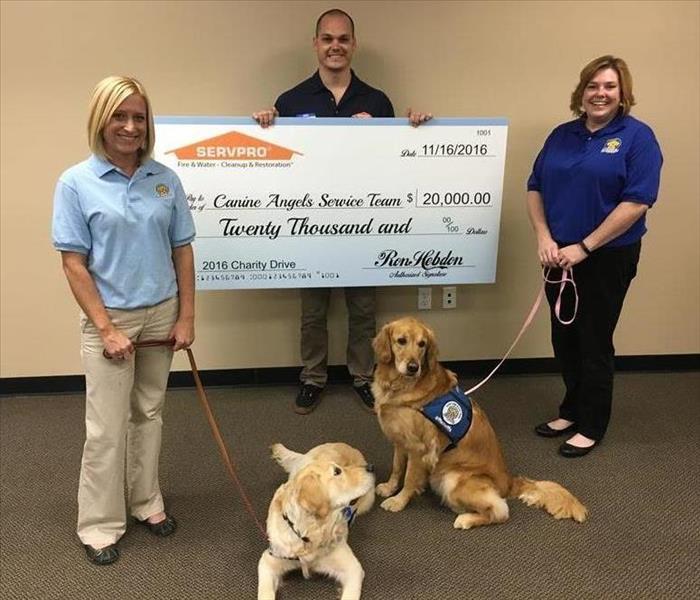 Canine Angles team along with Calypso and JJ receive a gift from our very own Christopher!
Canine Angles team along with Calypso and JJ receive a gift from our very own Christopher!
Helping Weave The Fabric of Our Community
Being a local franchise of the Riverside area in CA, we get to experience the community first hand. We are professionals trained to perform our professional services, but we also care for our clients and community. When we heard of an organization called "Canine Angles Service Team" helping our local and neighboring communities, we had to take a closer look. We liked what we found and decided to help them make a change and deliver a good impact to the life of others.
Canine Angles Service Team is a company that provides highly trained service dogs specifically to children. We were touched by the help and joy that this organization brings to others and decided to seize the opportunity to help them with their quest to bring service along with a smile to our community. We were able to make a very nice contribution to their work and even though we did not expect anything in return, we were rewarded with meeting some of the team members which included Calypso and JJ the service buddies! Here is a link to their website should any like to read more about the great service they provide.
Canine Angles Service Team
On behave of SERVPRO West Riverside City, congratulations Canine Angles and keep up the good work!
The grilling fun isn't over!
7/22/2015 (Permalink)
Here are a few simple tips to keep in mind this summer while cooking...
Emergency Preparedness Checklist
3/25/2015 (Permalink)
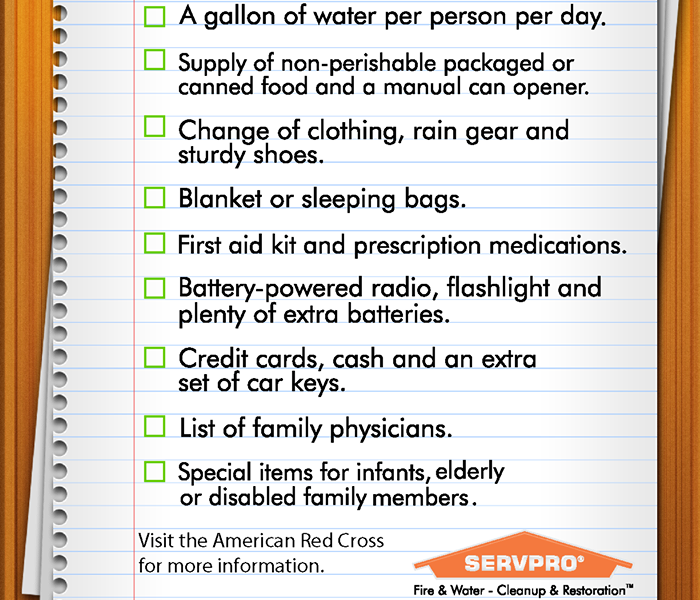 Emergency Preparedness Checklist
Emergency Preparedness Checklist
This week we're gathering supplies for our Emergency Preparedness Kits. We'll show you how it turns out, so you can make one for your home or business.
Check out our Twitter Page
 A simple "Thank you for your service" can be a great way to show you respect and appreciate what he or she is doing for the community!
A simple "Thank you for your service" can be a great way to show you respect and appreciate what he or she is doing for the community!






 24/7 Emergency Service
24/7 Emergency Service






























